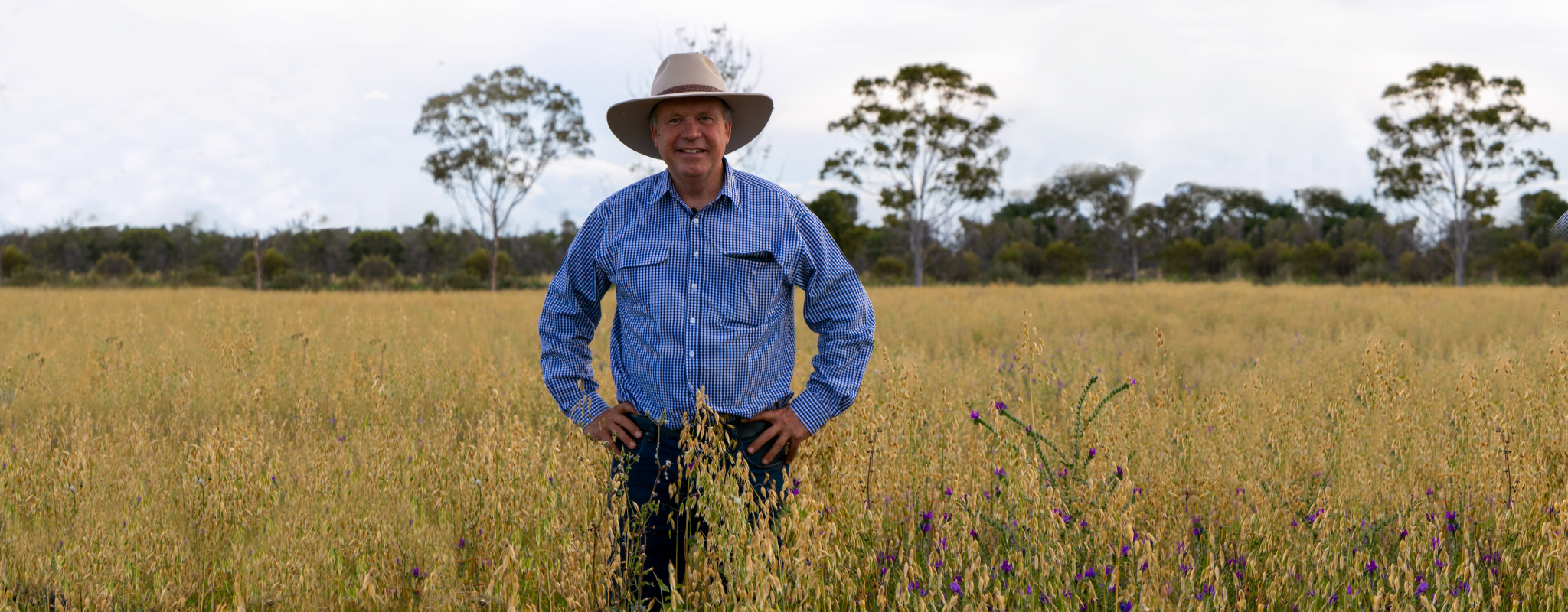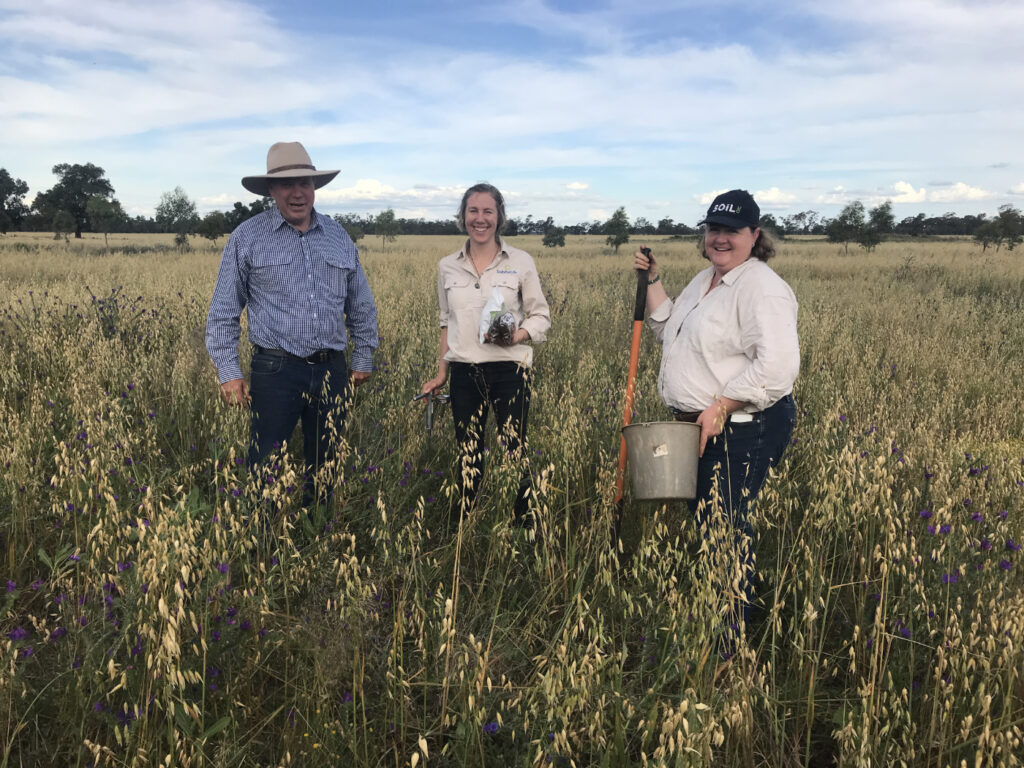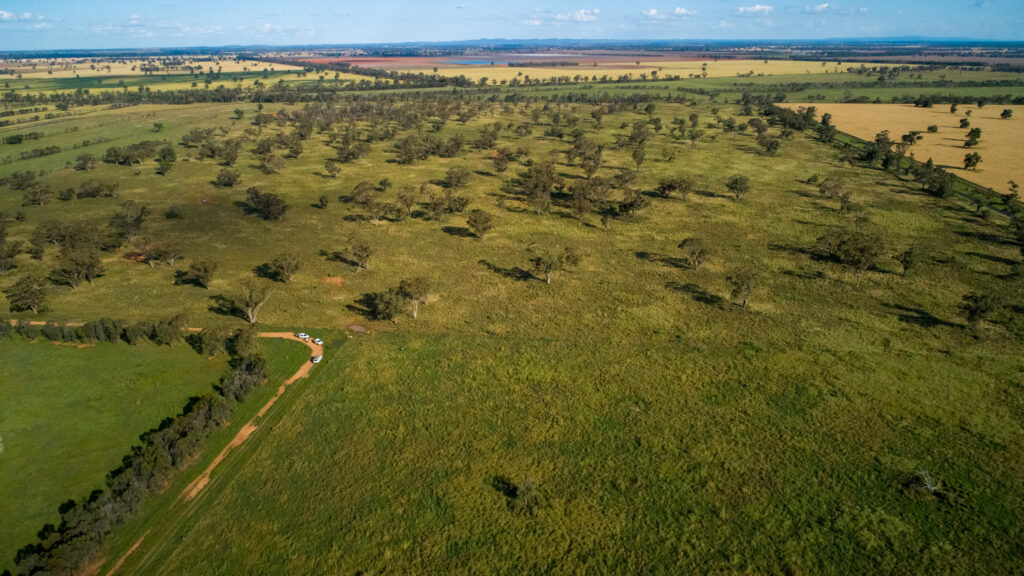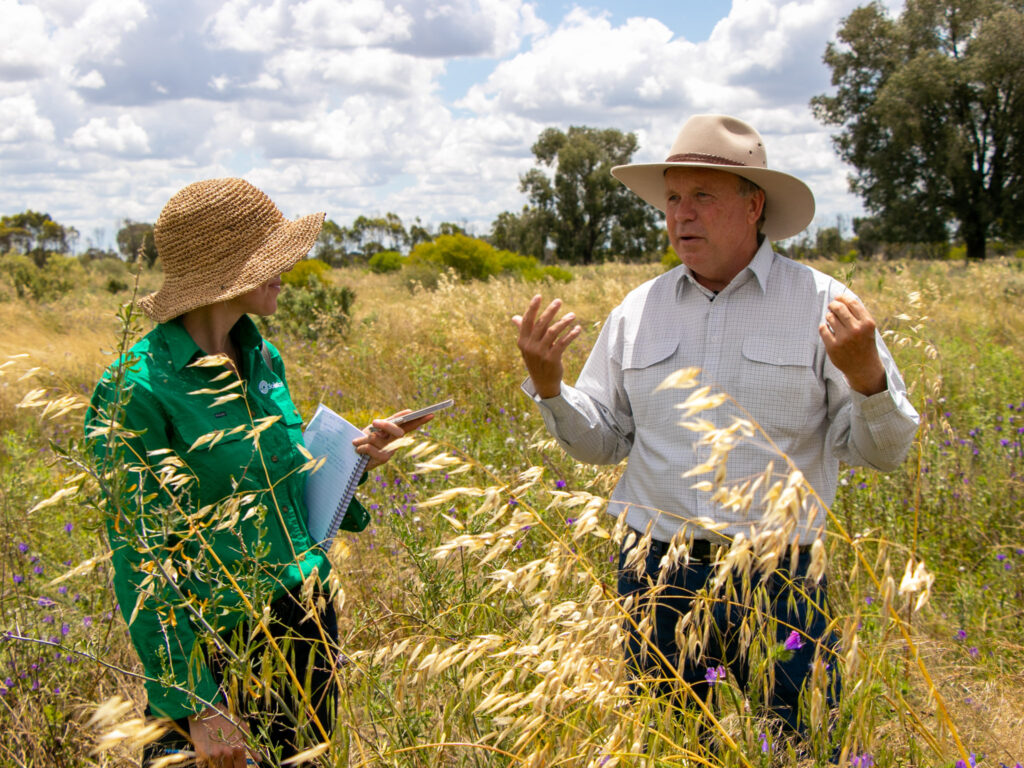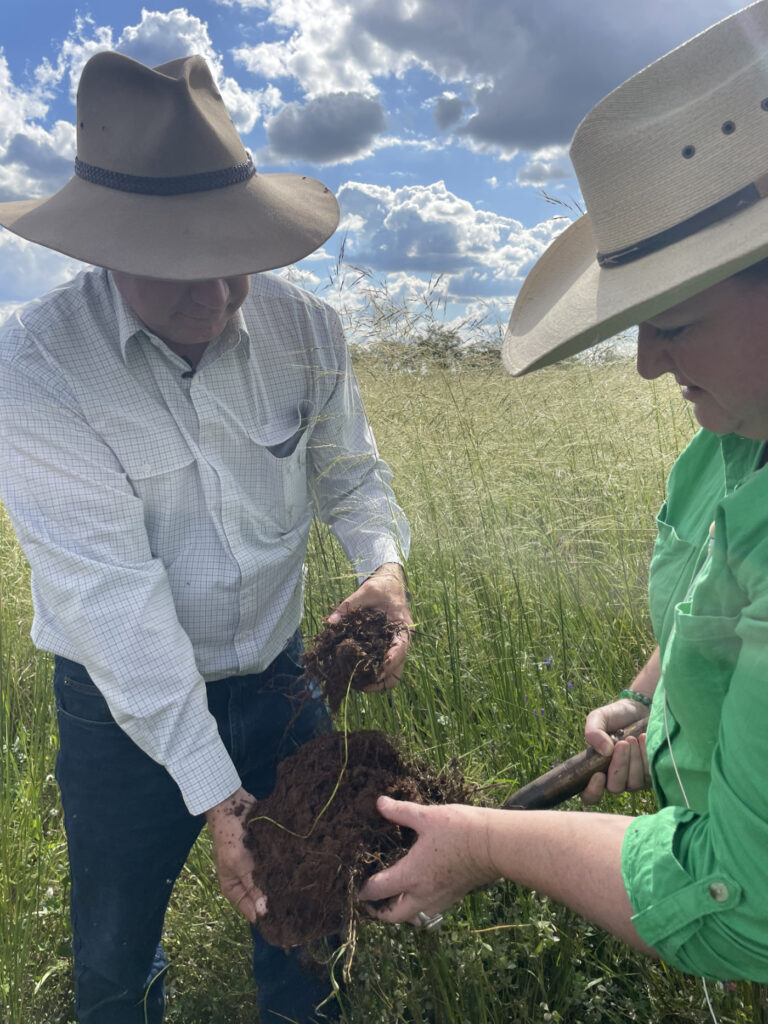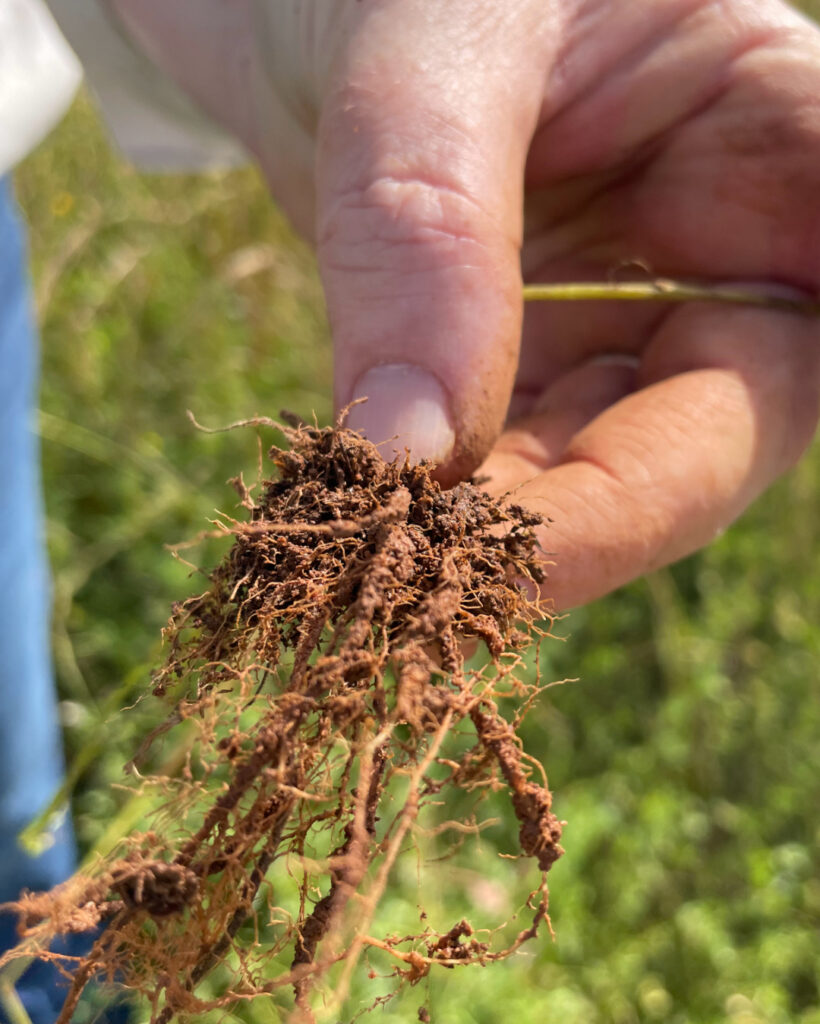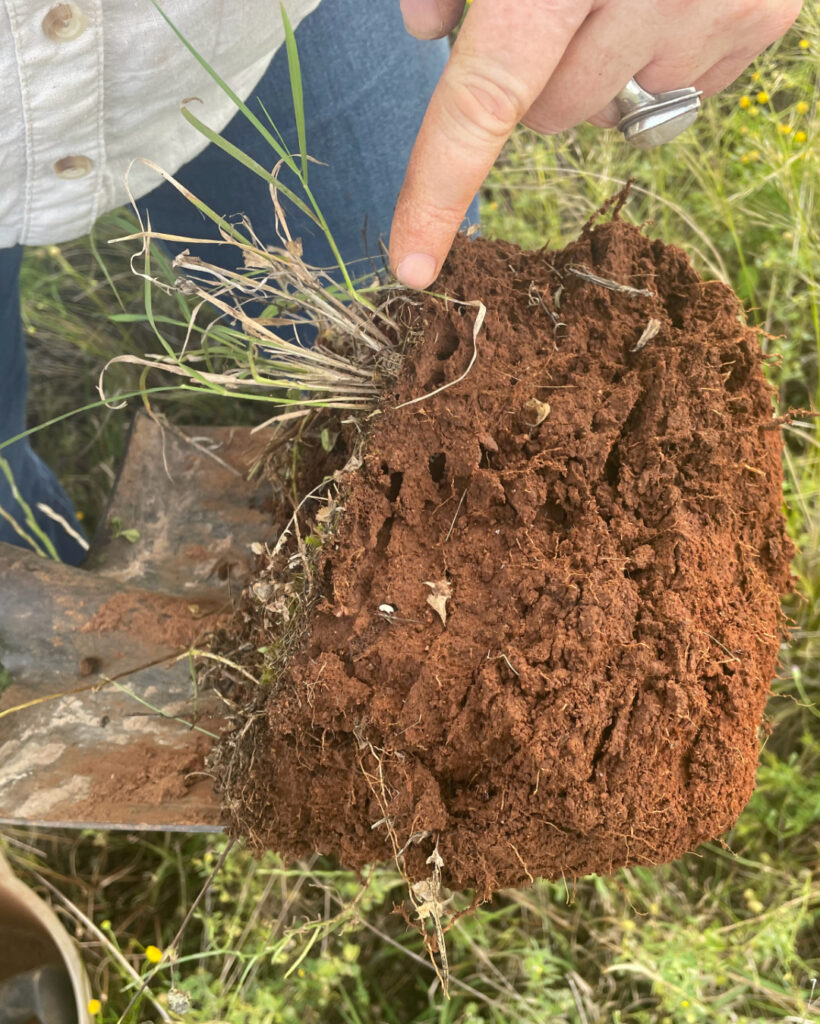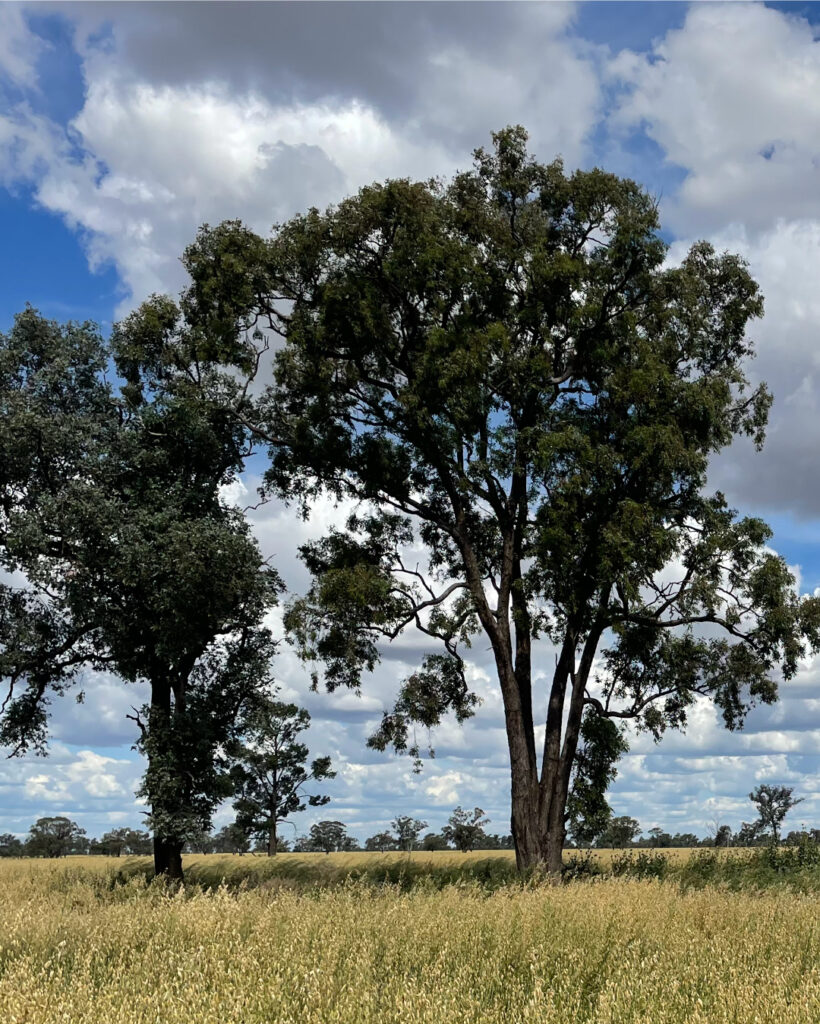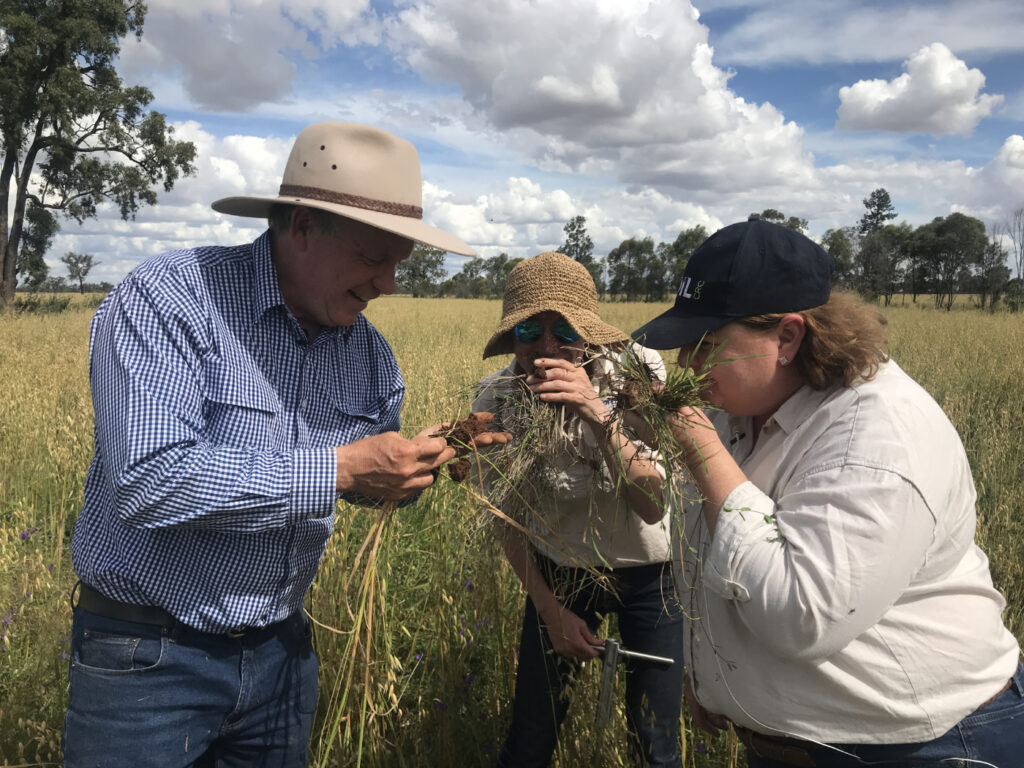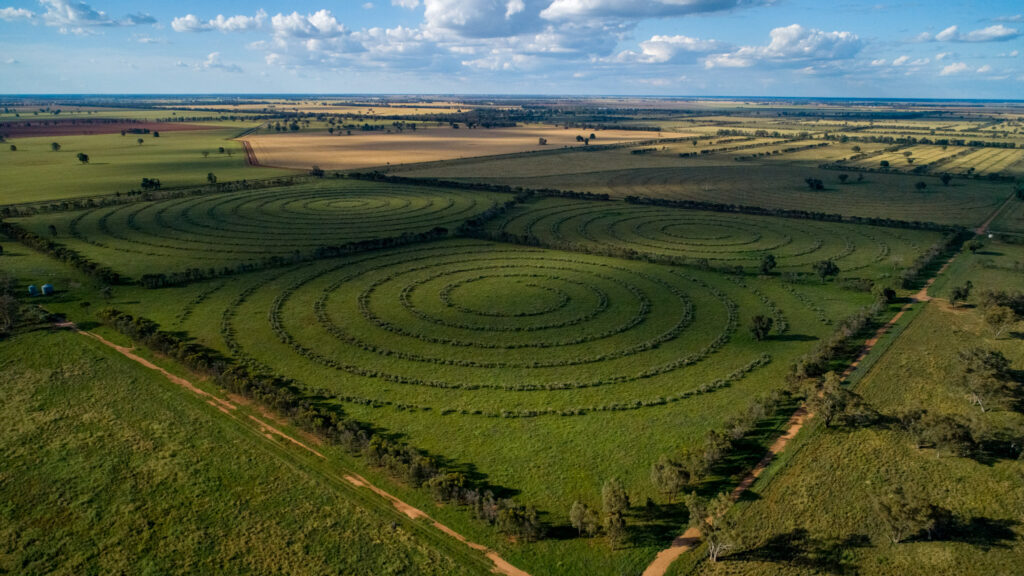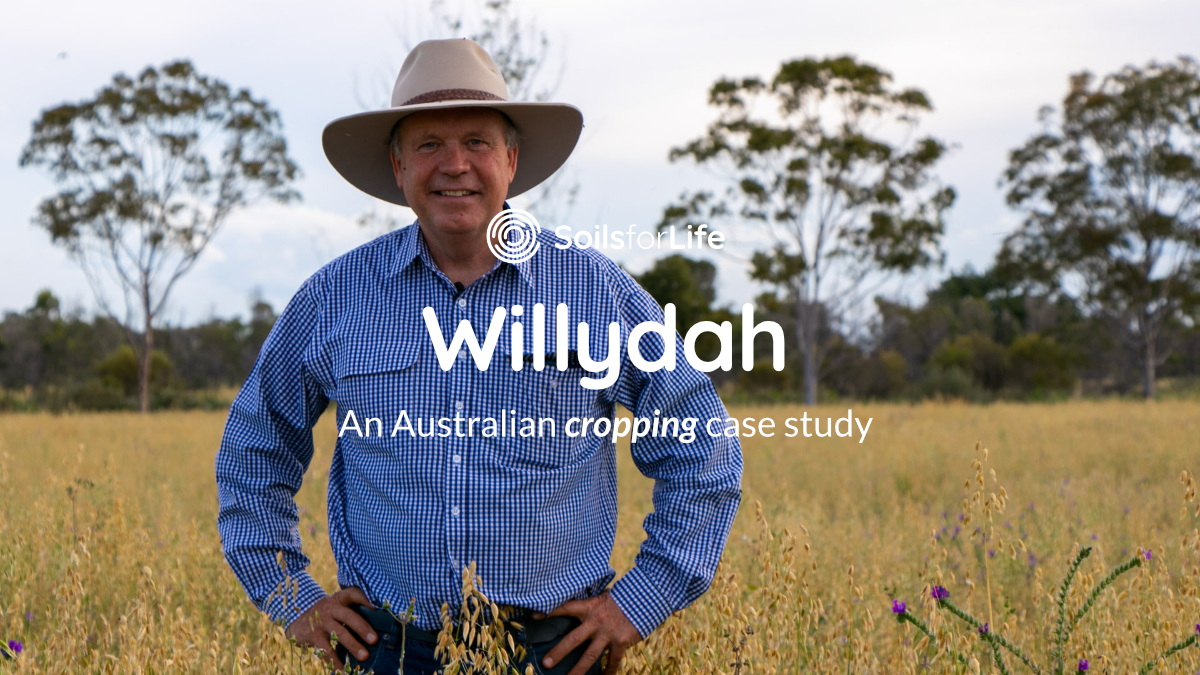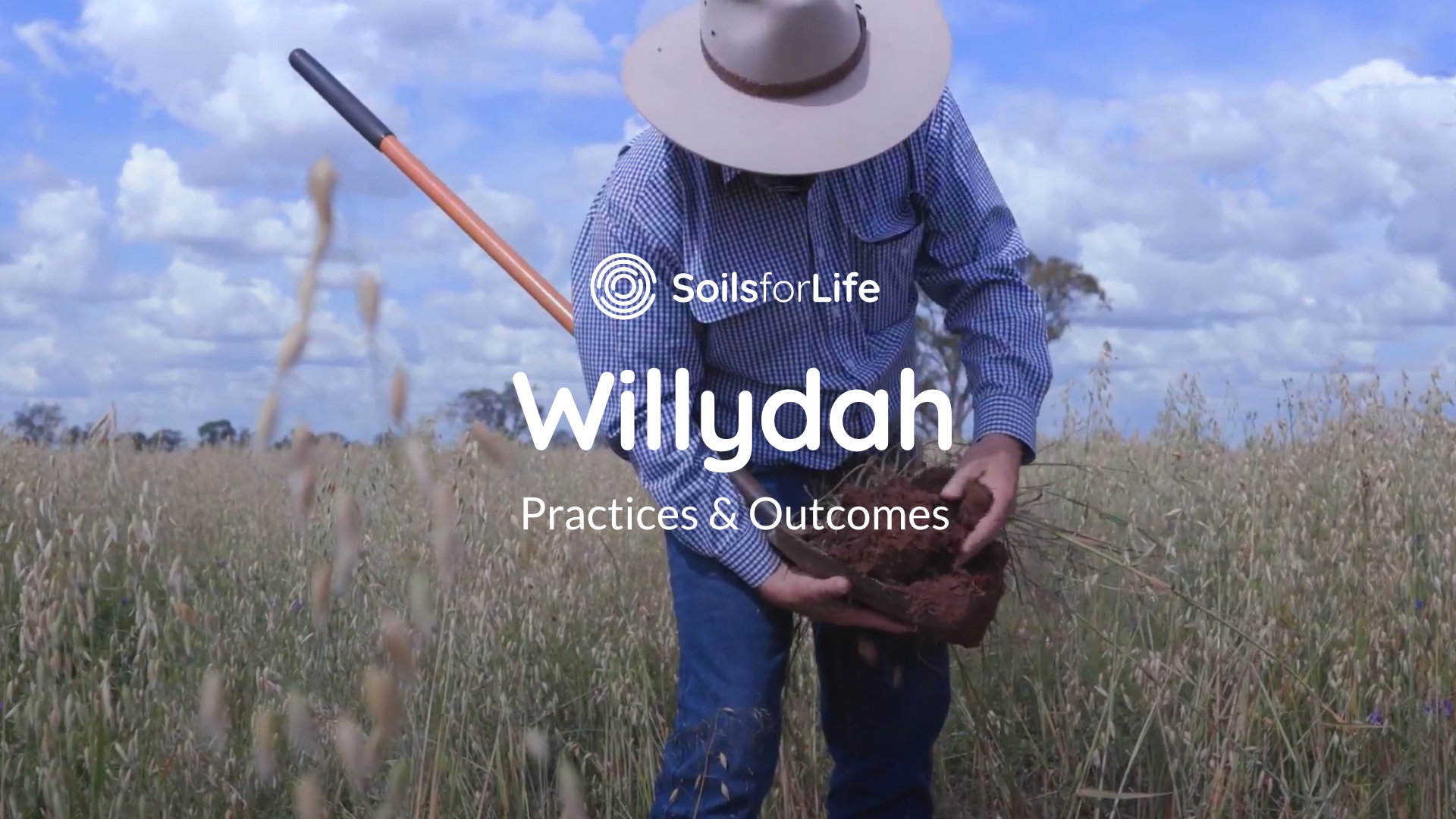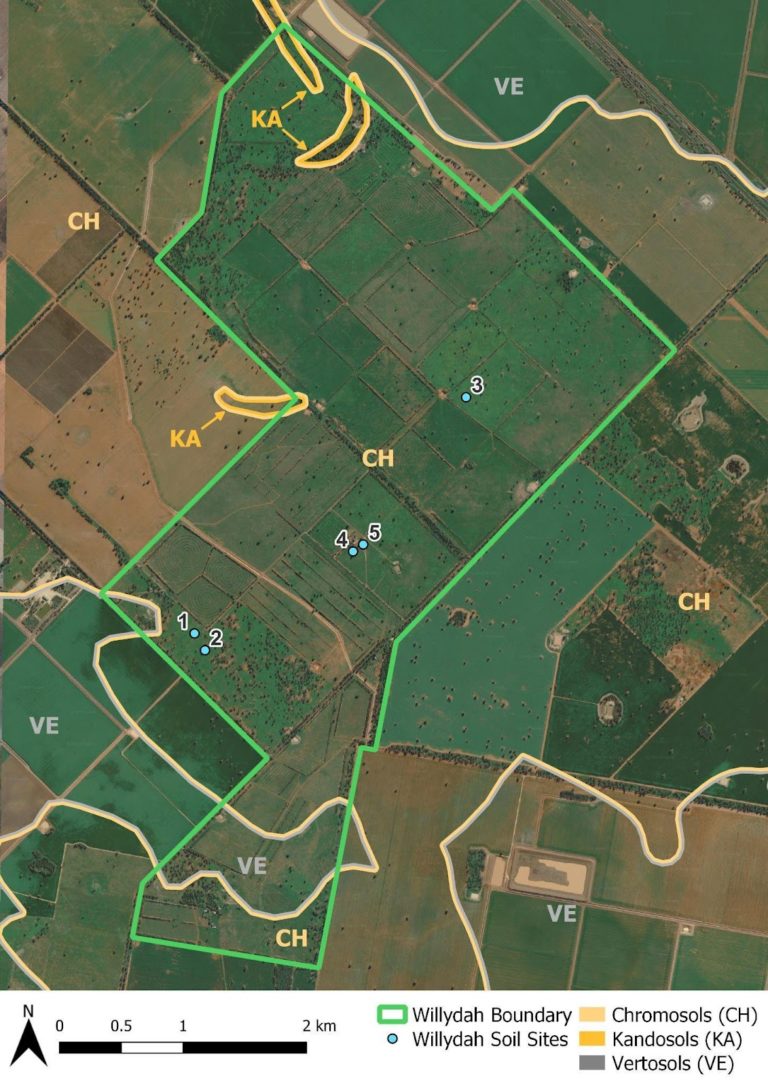The Maynards at Willydah
An Australian CROPPING CASE STUDY | Updated August 2023
Bruce grew up farming with his parents. Through a strong sense of curiosity and a bit of luck in his early farming years, Bruce was able to demonstrate totally new practices of cropping and grazing and change the trajectory of his family farm.
A profound shift happened for Bruce after taking Stan Parson’s Grazing For Profit course in 1994. By implementing these grazing practices, Bruce and his parents saw the ‘whole grass layer’ and soil surface transform.
However, when the time came for cropping, Bruce couldn’t bring himself to take the increasingly diverse grassland ‘back to zero’ by cropping in a way that negated all the diversity and production increases being gained by the new grazing practices.
So, Bruce sold his cropping machinery, and created a small machine to plant directly in the grassland. As luck would have it, they trialled the machine in January 1996 at a completely dry time, and when the autumn rains came, it became ‘abundantly clear’ that sowing dry allowed the planted cereals to compete strongly with all the other plants, and greatly improved the food ration in the field for their grazing animals.
Since then, Bruce and his family haven’t looked back from their paradigm shift of sowing dry into existing grasslands. An essential component of the method they created, now known as
No-Kill Cropping, is livestock grazing. To build upon grazing methodologies, the Maynards developed their processes for Stress-Free Stockmanship and Self-Herding.
The next generation of the Maynard family – Liam, Ella and Hannah – are now taking more ownership of the cropping process, and they are exploring new markets with brewers and bakers that are interested in the unique local provenance characteristics that the No-Kill Cropping provides. As their practices of integrating grasslands with cropping and grazing continue to evolve, particularly while managing the challenges of climate change and biodiversity loss, Bruce remains keen to share the ideas of No-Kill Cropping as a:
Low intervention practice that still produces food to feed 8 billion people using less resources while reinstituting landscape function and rebuilding soil over massive areas of the whole globe, as that’s what grasslands all do.
Bruce’s efforts and contributions were recently recognised when he won the 2022 Bob Hawke Landcare Award for excellence in sustainable agriculture.
Farm Facts
Location
Wiradjuri and Wongaibon Country | Narromine, NSW
Climate
Hot dry summer, cold winter
Average Annual Rainfall
554 mm (1992-2022)
Agro-ecological Region
Temperate sub-humid to dry (semi-arid)
Property Size
1,400 ha
Elevation
240 m
Social Structure
Owner and operators
Enterprise Type
Mixed enterprise cropping, beef cattle, sheep
Growing Region
Northern Region (Central East NSW sub-region)
Landscape
Depositional plains of alluvial sediments (originally deposited by the Macquarie River) and channel deposits associated with open woodland, shrubland, and grassland vegetation.
Soils*
Mostly texture-contrast podzolics (Chromosols), grey and brown cracking clays (Vertosols), and uniform or gradational earths (Kandosols) of the Trangie soil group.
*Learn more about soil classifications at Soil Science Australia
Videos
The Highlights
Practices and Innovations
Helpful Strategies
Indicators of Progress
- Developing and refining No-Kill Cropping, and its five principles
- Developing and implementing a method of Stress-Free Stockmanship
- Co-developing self-herding methods
- Encouraging a holistic and integrated grass-shrub-tree landscape by planting 350,000 saltbush shrubs and 200,000 trees
- Pursuing value-added streams of brewing and baking with multispecies harvests
- 100-year whole farm plan with multiple generations
- Seeking profitability rather than maximising productivity
- Maintaining a systemic view of farming, e.g.practicing cropping and grazing as an integrated whole across the farm
- Adopting a collaborative, teamwork approach amongst multiple generations of family
- Using his training in quality assurance to structure constant learning and improvement
- Running small experiments, making observations, running the numbers, adjusting
- Early succession planning and active management transitioning
- Keeping simple standardised records to enable a quick economic return analysis of interventions
- Reducing economic vulnerability to input costs by removing any fertilisers or pesticides
- Always keeping an eye on the influence of decisions on long-term capital value
- Zero chemicals or synthetic inputs and significantly reduced fossil fuel use
- An estimated 80% reduction in variable costs, equivalent to $400 savings per hectare in an average year
- Combined gross margins for the cropping and stacked livestock enterprises estimated to outperform the typical cropping-only gross margins in poor years
- Reduced cost, increased choice and flexibility, elimination of chemical use and reduced exposure to climatic and market volatility have all had a positive benefit on Bruce’s personal wellbeing.
Cropping landscape and soils
About the landscape
The Willydah landscape includes remnant and restored open woodlands, shrublands and grasslands on the undulating low hills and plains of the Darling Riverine Plains. The property is located on alluvial sediments originally deposited by the Macquarie River, also known as ‘Wambuul’ (Winding River) in Wiradjuri language.
The depositional plains of the Macquarie River are identified as Meander Plains, Back Plains, or Channel deposits depending on their location, elevation, vegetation, and soil characteristics (DPE, 2013). The most common land uses in the region are the grazing of cattle and sheep, and rainfed and irrigated cropping.
The climate is characterised by warm to hot summers and cool to cold winters and rainfall is relatively evenly distributed across the growing seasons, although springs and summers are slightly wetter than winters. Water supply on Willydah is a combination of surface capture (dams) and sub-artesian (non-flowing).
Nine plant communities have been identified on Willydah, none of which are listed as Threatened Ecological Communities (TECs) within the Darling Riverine Plains Bioregion. The dominant communities are: the the poplar box, white cypress pine, wilga and ironwood shrubby woodlands on the texture-contrast podzolics; the plains grass grasslands on the clays; and the western grey box, poplar box, and white cypress pine woodlands on the earths.
From an ecological perspective, biodiversity on Willydah had been building over many years, however many species have been adversely affected by what is understood to be chemical drift. Up until 2012, there had been an explosion in bird numbers, but these numbers are again in decline. Bruce believes that birds are an excellent indicator of change, and claims that when the wrens endemic to the region return, this will indicate a return to the trajectory of increasing biodiversity.
About the soils
According to existing mapping (Figure 1), the dominant soils on Willydah are texture-contrast podzolics (Chromosols), which are identified by an abrupt increase in clay down the soil profile. These soils are most common on the Meander Plains.
Grey and brown cracking clays (Vertosols), which are identified by their high clay content and their shrink and swell characteristics, occur lower in the landscape and are a feature of the Back Plains and Channels (DPE, 2013).
There are minor occurrences of uniform and gradational earths (Kandosols), which are distinguished by their uniform or gradual increase in texture down the soil profile and their lack of structure. These soils also feature on the Meander Plains.
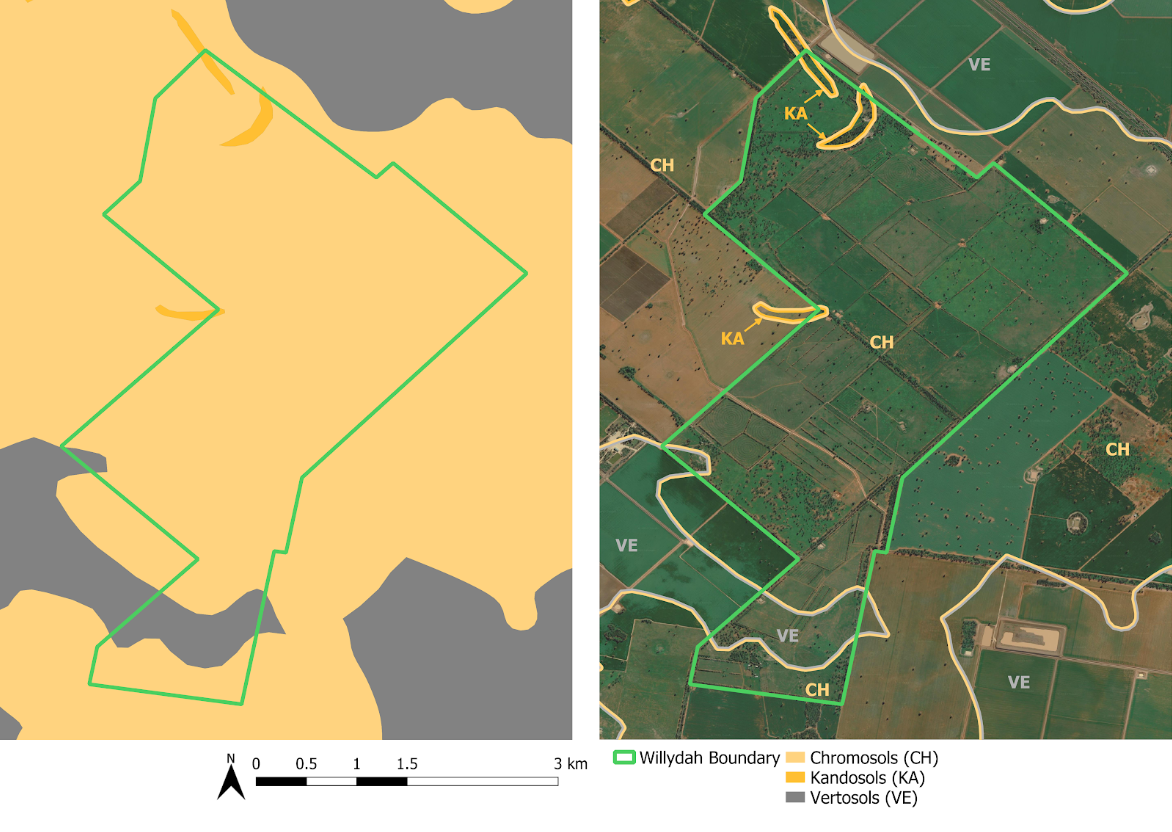
Figure 1. Representation of the Chromosols (texture-contrast podzolics), Kandosols (uniform and gradational earths), and Vertosols (grey and brown cracking clays) at Willydah (based on existing mapping). Source: Soils for Life. Note: These soil boundaries represent a broad scale overview and are not derived from detailed soil information.
The Willydah story
- Phase 1 - Recognising tensions
- Phase 2 - No-Kill Cropping
- Phase 3 - Refining livestock behavioural science and practice
- Phase 4 - Now and into the future
Recognising tensions
Before 1995
Bruce Maynard is a fourth generation farmer, currently living and working on the family property near Narromine, NSW. He grew up hearing stories of how the landscape had changed over time, like how the ‘scarifiers [blades for removing thatch and roots] would completely stop and they’d have to lift them up and get the worms off because they were just dragging too many worms.’
Bruce always had an affinity with nature, and was interested in resource management. As a conservation grazing officer for Landcare in the early days, he also noticed some troubling trends, and he attributes his decision to change his farming practices to several standout moments.
Influence of US farming communities
Bruce considers himself lucky to have spent time in the upper Midwest of the US as a Rotary exchange student in 1984, as the trip triggered ‘a journey of thinking and discovery’. He was surprised that many American farmers were going broke at proportionately higher rates than Australia, even though farmers in the upper Midwest were well resourced in terms of soil quality, water availability, and government support, e.g. resources that ‘we would only dream of having here’ in Australia. This ‘searing experience of having American schoolmates going to clearing sales’, led Bruce to the conclusion that more resources weren’t necessarily the solution for struggling Australian farmers.
Simultaneously, amongst these trends of ‘farms going broke and conventional approaches being hailed as best practice’, the Amish and Mennonite families in the Midwest, who practiced low input, low capital approaches to farming, were ‘buying farms for cash’. This observation prompted Bruce to reflect on ‘the fundamentally solid business practices of these communities,’ and the difference between profitability and productivity, which Bruce later integrated into his practice of No-Kill Cropping (see Phase 2).
Following best practice
Bruce returned from the US and continued helping his parents on the farm. Most seed bed preparation and weed control in the mid-eighties involved tillage with long lay fallow periods where the paddocks returned partly to grassland. Bruce felt this approach with continuous sheep and cattle grazing – which his family had been using for decades – enabled them to restore some soil fertility over time.
In the late 80s, Bruce’s parents transitioned to what was recommended by independent experts at the time and thought of as ‘the best practice’. In this seven-year rotation, with four years of lucerne and three years of cereal cropping (wheat, barley, oats), the cereal crops were direct drilled with full disturbance in a single pass, and sprayed once in a growing season for broadleaf ‘competitor plants’. However, outside of the growing season, Bruce describes how they ‘controlled weeds via livestock rather than chemicals’.
Observing a decline
Initially, the Maynards felt the lucerne was well adapted to their ‘very hot and dry summers’ but eventually it became clear to Bruce that this ‘best practice’ had challenges. Lucerne created a ‘hostile soil surface condition’, which ‘induced a lot of structural decline on our harder setting soils even though we had legumes pumping nitrogen into the soil.’ In addition, it ‘was very tough times with high interest rates’, which prompted Bruce to ask:
If we keep on intensifying and improving the efficiency of those current systems, where does that lead us? And inevitably the only answer to that was more intensity and more activity.
Bruce realised that this narrowly correct ‘best practice’ was ignoring the larger whole, and that ‘creating a simplified system would eventually lead to more intensification.’ He describes this phase as ‘single species dominance that we were imposing on the landscape and that had consequences for the soil in particular.’ He also felt degrading the soil structure, only to pump in external forms of nutrients, wasn’t his answer. So:
We began changing our strategic directions in the early 1990’s in response to the accumulating evidence and experience that conventional and recommended farming practices were not going to achieve simultaneous improvements in sustainability and profitability.
Commitment to whole farm planning
In exploring new strategic directions, Bruce was ‘heavily influenced’ by the Potter Farm Plan in Victoria. This ‘precursor to the Landcare movement’ was a whole farm planning process led by Andrew Campbell. Beyond production, this process also integrated natural factors such as wind flows, water flows, access laneways, diversity and ‘a lot of things’ which Bruce ‘hadn’t seen before’. He watched their ‘quite radical at the time’ videos many times, which ‘certainly helped me as a precursor to our whole farm plan.’
When undertaking their own whole farm plan in 1990, one provocation in particular profoundly impacted Bruce: plan for a hundred-year outcome. Bruce found this question an ‘infinitely useful thing’ because it was:
The right way to look at things, not just reacting to the way things are now, but really truly imagining something that’s beyond your own lifetime. How would you like the grandkids to be experiencing it? That’s a really deep and wonderfully fundamental question.
Another beneficial aspect was undertaking the planning with his parents. Bruce felt he could ‘throw his imagination at it’, whereas his parents brought the deep experience and understanding of themselves, their parents and grandparents.
Change in grazing management
Implementing the 100 year vision began with addressing the over-simplification of the landscape. Bruce sought to return a scrub layer into the ecosystem with saltbush plantings. He also implemented access laneways for ease and efficiency of moving grazing animals.
And because the 100-year plan provided the ‘license to dream big’, Bruce also actively looked for new agricultural practices. At that time, the first practices of grazing management change were coming into Australia, so Bruce ‘read whatever I could get my hands on’ before doing a Grazing for Profit grazing management course in 1994 with Stan Parson, which he found ‘transformative’. Bruce realised, however, he needed buy-in from his parents to make changes. So both generations of Maynards ran a number of trials of alternative enterprises. They took their time, observed, looked at the practice change from everybody’s unique perspective, and ‘slept on it’.
Stan Parson’s strong business focus also prompted the Maynards to review whether the breeding of sheep or breeding of cattle was most profitable at that time. Reviewing the numbers highlighted that fattening would pay off, and so they transitioned from mainly sheep to mainly cattle. Even though they had a similar dry sheep equivalent (DSE), Bruce feels that ‘having the cattle alone enabled significantly faster progress as far as the biology and diversity’ in the soil conditions and landscape at that time. The equivalent livestock units of cattle, with their very different grazing behaviour and relationship with the land, had a radically different impact leading to more grassland productivity. And the ‘business and biology swirled upwards in a progressive feedback loop’.
Over the rest of 1994 and 1995, Bruce realised the fundamental change that time-controlled rotational grazing had on the landscape. By ‘making the majority of the place’ not have livestock on at any one time, the ‘whole grass layer’ transformed. He and his father came across plants they had never seen before, and trees recruiting in places his father had never experienced.
In addition, their accounts of grazing days and stocking rates over the whole year showed that their best lucerne paddocks were meeting the average of their uncleared paddocks and remaining grasslands. In other words, their uncleared paddocks were just as equipped, if not better equipped, to meet the feed requirements of their stock when compared to their ‘improved pastures’. This was a ‘big economic signal’ to Bruce:
Our main difficulty as a livestock farm is keeping animals the whole time, not just getting huge bursts of performance and then nothing to feed them, so that was a big economic signal to me, and we hadn’t ever had a way of recording that before.
While Bruce was determined that any decisions with the ‘newfangled grazing’ wouldn’t upset their whole farm plan nor long-term capital value, in 1994 they transitioned from 30 to 113 paddocks. Looking back, Bruce appreciated that this practice change took place during a very bad drought period:
I felt it was a much, much better learning experience for me when times were difficult, than if we had good seasons because we still saw progress even though it was terribly dry times. But then during a very wet period in 1996, the landscape really bounced and we went into a whole change of state.
A new tension between cropping and grazing
With these initial practice changes, a new tension emerged between the more complex grasslands and their cropping. Bruce could not reconcile the increase in paddock diversity and productivity during its rest period with ‘taking the paddocks back to ground zero with a cropping regime’. He couldn’t see how a ‘saw tooth pattern’ (e.g. ‘growing all these plants and grass only to reduce it’ with one cropping intervention) would actually progress paddock health. In addition, Bruce felt that the continual intensification of cropping was reaching limiting returns. ‘Every year we’d have to edge more’ to get the same economic result, and he observed that the industry as a whole was ‘making up for lack of productivity per unit area by consolidating farms and increasing scales’.
So Bruce concluded, ‘this is not the way we’re going to keep going. I’m going to burn my bridges here’. He sold all the big machinery – ‘the whole lot’. ‘We really didn’t have a path at that stage’, Bruce recalls, but decided to put together an interim machine for intercropping in grasslands. They tried this ‘over-sowing approach’ using a double disc unit fitted to old seed delivery equipment on about 80 ha. While these discs were new to the Australian context, ‘if you were South American, you’d be yawning and say, “these have been around forever”’.
‘As luck would have it’, they tested the machine in a completely dry time in January. The discs were placing the seed about one centimetre beneath the ground and Bruce suggested to his father that they should sow everything dry. ‘My father walked away, that was just too much madness on that day!’
Taking things slowly, and with gradual handover of control, Bruce was able to sow a couple hundred acres dry. ‘When the autumn rain came’, they compared the performance of dry-sown paddocks with paddocks sown after the rain. Without chemicals or tillage, the seeds sown after rain were disadvantaged, but the seeds ‘sown dry competed quite aggressively with the other plants and performed quite well’. This experience was ‘the penny drop’ for Bruce. For the next three years, Bruce and his father increased the percentage of dry-sown crop until there was no more wet sowing, and ‘we didn’t go back to it, because we realized that we actually came up with an entirely different cropping system.’
No-Kill Cropping
1995 - 2006
The whole farm plan, which had begun in 1990, continued over the following 15 years, and there was a gradual handover of roles and responsibilities between Bruce’s parents and Bruce, while they worked together to implement the 100 year vision. (Yet even today, Bruce will discuss ideas with his mother, because ‘why not get access to more wisdom?’).
During this time, Bruce refined the practices of No-Kill Cropping with his repurposed combine seed drill with new disc coulters. He describes No-Kill Cropping as an ‘easy set of practices’, distilled into five principles, on a ‘branch of the cropping systems family tree that is quite different in some fundamental principles from other methods.
Principle 1: Sow when the topsoil is dry
Contrary to common practice ‘for the last 10,000 years’, the first principle is to sow when the topsoil is dry.
Bruce learned that creating a one cm-deep and a half cm-wide disturbance to drop in the seed is ‘the perfect seed-soil contact.’ Bruce describes this principle as a ‘10 meter start on the hundred meter sprint’, he typically finds three or four cm of growth four or five days after a rainfall events, while ‘the competitors are just starting because you haven’t disturbed anything else’:
If you wet sow, you’ll always have to do something about plant competitors as they are getting a start ahead of what you are trying to grow; while you are having to wait to get there with your machinery for sowing, they’re germinating as soon as the moisture and temperature is right, and they’re growing and going, going, going. Whereas with No-Kill Cropping, as soon as we got rain, the seed sprinted out of the box.
Bruce observed how this minimal disturbance changed the types of plant species growing in the paddocks. Previously, when they were tilling, they would see plants such as thistle or Mexican poppy grow, whereas with very little disturbance, ‘uneconomical plants’ like that would ‘revert to mostly a background or virtually none at all’. Bruce suspected that if they went back to tilling and plowing, he’d get some ‘very pretty paddocks of Mexican poppy.’
In addition to beneficial cropping germination rates, Bruce observed the soil benefits of cropping dry. The comparatively light-weight ute pulled the disc machinery when the soil has maximum strength, which minimises soil compaction. Alternatively, ‘with wet sowing in conventional systems, we were going over the soil when it is most vulnerable, just like road builders when they moisten soils before compacting it’.
During this time, Bruce also recognised that the opportunities to grow a large amount of commercial crop were more limited in his No-Kill approach, and No-Kill Cropping was relying on ‘in crop rainfall’ and water holding capacity of the soils (as compared to other practices using transient water by how they managed their bare fallow periods). But, in the first few years of this over-sowing approach, Bruce really started to grasp the potential, thinking:
My goodness, this approach can reinstitute grassland function everywhere. We can still crop and even if we’re just interested in animals, we’ll grow more biomass at a tiny economic and resource cost.
Principle 2: Place seed in soil using straight-running disc machinery.
In Phase 2, Bruce observed soil and economic benefits from the straight-running disc machinery. The straight coulter discs minimised the disturbance of the above and below-ground communities, and limited any carbon loss of his soils. In addition, the straight-running discs experienced such little resistance while sowing in the dry season, he used far less fuel, with significant cost savings.
Bruce experimented with growing different winter cereal crops, pasture species such as legumes, and summer crops like sorghum and millet, but mainly stuck with oats, as it was easy, consistently cheap, good animal feed, and he hadn’t seen any major disease from planting the same annual year after year (because of the hundreds of types of other grassland plants in the paddocks).
Principles 3 and 4: Don’t apply chemical pesticides or fertilisers.
Bruce’s main goal was to avoid simplifying the landscape, so he did not use chemicals or pesticides. Bruce also applied this rule to his seeds, sourcing seeds that hadn’t been pre-treated with any pesticides.
In addition, he did not want to give an advantage to introduced annuals over native species, so he did not use fertilisers. By cutting out these inputs, his costs were lowered, and he believed it took out some of the economic risk of his operation.
Heartened by one of his inspirations, David Tillman, a scientist from University of Minnesota (who found that ‘once they got past six or seven species in a plot’, it became very hard to transmit disease), Bruce considered every plant as valuable to rebuilding the grassland and soil health.
Principle 5: Effective grazing to return nutrients for plant growth.
Bruce started to see how cropping, grazing and landscape diversification could all work together as a whole in synergistic ways, and so effective grazing became an important principle of No-Kill Cropping.
Prior to 1995, Bruce wouldn’t put stock in paddocks after harvesting, as there ‘wasn’t much left but spilt grain and straw’, and it ‘seemed like a lot of trouble for not much gain’. But by introducing crops over the top of grassland, Bruce widened their grazing management options throughout the whole year. Instead of harvesting the cereals and feeding them back to the animals in tray-feeders, it was ‘financially and logistically attractive’ for the cattle to ‘harvest the high-quality stand-over feed in the field as a self-feeder’ at the time when it best suited the animals and Bruce financially. Essentially, Bruce was increasing the size of the ‘haystack’ in the field for the animals to feed themselves, telling his parents, ‘We’ll leave that crop and get the four-footed harvesters rather than the rubber-tyre ones.’
The Maynards found it ‘a lovely surprise’ to be able to transition from a ‘checkerboard of distinct cropping and grazing land to a much more integrated and fluid situation’. Bruce exclaimed, ‘this goes to the heart of my laziness’ because seeing the cropping and grazing as an interconnected whole provided him with more options and less stress, while saving time and resources compared to how the grain was grown and fed to the animals previously. Because of this approach, people called Bruce the ‘lazy farmer’, but his philosophy is that ‘we shouldn’t be busting our bum’ as farmers, and he embraced the term. The animals, in eating and recycling plants, were adding nutrients back into the soil, and also doing better at rehabilitating the grassland for more diversity, without heavy intervention.
Stress-Free Stockmanship
Not only was it important for Bruce to be less stressed, but he wished the same for his cattle as part of effective grazing management. Building on the work of Temple Grandin’s positioning (Level 1 stock handling) and Bud Williams’ low stress handling (Level 2 stock handling), Bruce began to explore livestock behavioural science. Through his reading and farm experiments, he developed and codified a method of ‘Stress-Free Stockmanship methods’ in 2000 as a Level 3 behaviour management technique. His goal was to help animals learn positive behaviour in order to benefit the landscape.
In addition to the cycling of nutrients and microbial diversity to the soil, one of the other benefits Bruce found for the landscape and the animals was the change in the total livestock diet. His cattle would now eat novel and diverse foods by choice. Because the oat crop was ‘high energy and low toxin’ food, the cattle would then complement the crop with the other ‘componentry’ in the field, which might be ‘higher toxin, low energy plants’, such as Patterson’s curse. In other words, Bruce found that a high nutrient, low toxin crop mixed with many grassland plants in close proximity allowed for the animals to eat more diverse foods. Bruce observed that these increases in novel foods, along with the decrease in stress, increased the cattle’s health, and that increasingly, some customers are willing to pay a price premium for the taste, nutrition and ethics of animals raised in a low stress environment.
To harvest or graze?
Over these years, there were several considerations of whether to harvest, harvest and graze, or just graze the crop. Bruce would consider a slew of factors, such as the life cycle stage of the cattle or sheep, the vegetation phase, the value of the commodities and meat markets, the weather events and volume of the cropping growth. For example, if Bruce had ‘some lambs for a contract that needed better performance,’ he’d ‘do the maths on opening the gate and letting them into the paddock versus the opportunity cost of harvesting’. As he had sold the machinery, he would also calculate the yield to consider whether to ‘bother getting a contractor in’ for harvest. In other words, he scanned his multiple options for the highest performing avenue.
While Bruce occasionally sold ‘a bit of crop off farm’, the numbers often pointed to ‘transforming the grain where it sat’ because ‘I put it in cheaply.’ Whereas previously the costs of sprays and treatments would have sent him on a ‘narrower and narrower set of train tracks’ towards maximising grain yield, in this new system, Bruce could still ‘sacrifice the crop even if it was looking good, as it went in at $10 an acre.’ He refers to his crop as ‘the cream’, because of his lack of ‘sunk costs’ during growth:
If I’d put in the grain expensively, I would’ve had to have gone to harvest, which was going against what I wanted to do personally, but it also didn’t show me the numbers at the time.
Even when there was a marginal decision of cropping being a little bit better economically, it wasn’t enough for Bruce to proceed, so he ‘put most of the crops through animals’ and the cash out point was largely the sheep, wool and beef.
Saltbush and tree planting
Moving on from the earlier saltbush plantings in 1990, Bruce also began experimenting with alley plantings (1998), target saltbush plantings (2004) and spiral saltbush plantings (2005). In addition to animals learning how to browse shrubs and thus adding diversity to their diet, Bruce learned over time that each type of shrub arrangement – block, alley, spiral – offered a unique benefit to their cropping/grazing system.
To continue the vision of an integrated, complex wood-shrub-grassland, Bruce also undertook significant tree plantings, including the ‘why-bother tree planting method’ (e.g. placing trees in the ground in wet conditions, 2001); direct tree seeding (2001); advance tree seeding (2002); and carbon tree plantings (2007). Around 104,000 trees were planted as part of the carbon sequestering project in 2007, which were also selected and planted to offer shelterbelts, shade, biodiversity and improve capital value. Importantly for Bruce, it was negotiated for the payment for carbon value to be made upfront (because, as discussed in Phase 4, it is believed that Passive Chemical Exposure drift is now influencing the health of these trees).
Refining livestock behavioural science and practice
2007 - 2021
During Phase 3, Bruce continued to progress his livestock behavioural science. Bruce experimented with locally adapted herds, Self-Herding approaches and complementary plantings via the No-Kill Cropping methods for a diverse animal diet. This period was also very challenging with what Bruce refers to as the ‘Anthropocene Drought’ (2018 – 2022). Over the last five years, and particularly since spending more time at home during Covid, Bruce’s son started taking over the reins with the No-Kill Cropping, and has evolved No-Kill Cropping at Willydah in positive ways that Bruce ‘wouldn’t’ have thought of or done’.
Self-replacing lamb herd
In 2009, working with and inspired by the work of Dr. Fred Provenza, Bruce created a self-replacing herd of sheep, lovingly called Maynard’s Mongrels. He wanted to make use of the incredible diversity he’d put back into his paddocks, and realised that, rather than just one breed, locally adapted animals would be ‘the go’.
During this time, Bruce had hair breeds and shedding breeds of lambs, as well as conventional meat breeds. They had 15 different breeds introduced including Vanroy blood with a taller frame, compared to Dorpers, with the logic being that taller frames would feel more comfortable in an increasingly hotter climate. Having their own animals also offered more self-reliance. As the breeds they selected are non-seasonal, they have three lambings every two years.
Self-herding of cattle
After seven years of behavioural science collaboration with Dean Revell, Bruce co-pioneered Self-Herding processes of livestock (Level 4 behaviour management). Instead of setting up permanent fences and infrastructure for cell grazing of animals, Bruce and Dean trialled signals – such as sights, sounds and smells associated with the potential for a delicious reward. As ‘anticipation is a bigger driver than the reward itself’, they set up addictive behaviours to use the anticipation of reward to move animals across the landscape,’ depending on the needs of the animals and the land.
In addition to the decreased need for expensive and potentially vulnerable infrastructure, this approach has many benefits. It facilitates moving and positioning animals in ways that are directly responsive to their needs, and the needs of the land. It also better allows the animal to self-medicate using their instinct, which Bruce also supported by growing a variety of medicinal shrubs in 2013.
Navigating and recovering from the drought
From 2018 to 2020, the Maynards ‘got down to some extraordinarily bad rainfall’, around ’85mm for the year in a 500mm zone’, and the whole landscape suffered.
Bruce decreased grazing to ensure sufficient ground cover and protect the soil surface. Eventually he had to stop grazing, but desiccation, soil deterioration, and ground cover loss continued. Eventually becoming bare soil, Bruce realised minimising soil deterioration was ‘out of my control.’ Bruce didn’t bother sowing, and reduced his lambs to 200 ewes, which was ‘still 199 too many.’
When the drought broke in February 2020, the landscape’s recovery provided a telling lesson to Bruce in terms of grazing management. He felt that his No-Kill Cropping management enabled a shorter recovery time, because he ‘left things more intact and had more landscape function there and ready’:
Leaving things intact meant we had the whole range of organisms waiting there, whether it was a burrowing frog or a myriad of other little things that have gone to greater depth where there is still humidity. The biology was sitting there waiting for its possibility to fire. The soil was dead-dry, but not dead.
Even so, Bruce waited six months after the rainfall to graze any stock on the property. Looking across the paddocks, it appeared there was ‘plenty of grass, but looking down at the paddocks, Bruce saw ‘everything hadn’t filled in, and it still needed time.’ Bruce needed income coming out of the drought, but he also knew that waiting six months before grazing would be advantageous in the long-term. Fortunately he was able to financially float this decision and allow the landscape to recuperate. When the land was ready, Bruce ‘bought in and bred up’ both the cattle and the sheep.
After the drought, the landscape had shifted. Bruce saw more thistles but still sees this as an improvement from before regenerating the grasslands, when they had ‘crops of thistles’. He also understands that the thistles are likely providing a function, like holding dry soils with low living plant mass together; and his landscape-adapted sheep will nibble the thistle when it is in a soft young stage.
Next generation engaging with No-Kill Cropping
In 2019, Bruce’s son Liam started expanding their cropping practices. Liam purchased a new tractor, which is ‘big scale’ compared to the 1995 set-up, yet still much smaller in capacity to what is used by other croppers in the area. A simplified design of what Bruce got in 1995, the tractor had a 10 metre wide air seeder fitted with a double disc engagement units, which sowed seeds at 11.5 inch intervals. According to Bruce, even though Liam increased their area of cropped land with this new set-up, the per hectare cost is equivalent to the cost of sowing in 1996 and less expensive when adjusted for inflation.
Using this new approach, Liam planted 800 ha of total crop area with a mix of commercial wheat and some oats in 2021.
Bruce and Liam started small comparison trials of the newer commercial wheat variety and a variety of the Maynard’s heritage grains from the 1930s. Interestingly, the commercial wheat grew really well in a disturbed site, like in their small test plot, but underperformed in a complex grassland community. However, as Bruce said, ‘if you gave the commercial wheat another chance in a different year in a No-Kill paddock’, it might do much better because the retained seed has started to evolve a relationship with the microbiome of the place.
Another reason that the new wheat variety may have had a ‘marginal result’, was due to a water-logged paddock. Bruce felt it was ‘hardly worth running the header over it’, but Liam wanted to harvest for their customers and keep seed for the following year. The benefit of harvesting and keeping the wheat seeds was that it’s ‘already evolved once’. With their on-site operations, they’ve found wheat is much easier to separate than oats. Liam is planning on sowing all potential paddocks every year, and Bruce believes this approach will be much more productive than his previous prior long term average of 700 ha per year.
Liam also bought a baler at a clearing sale, because according to his father, ‘he’s one of those people that can fix things that everybody else has thrown away.’ Liam ran the baler through the paddocks straight after harvesting, and because he didn’t have to wait for any of the green material in the No-Kill Cropping paddocks to wilt down, he created a new product of ‘graw bales’. The mix of grass and straw was a very useful resource during this wet year. It supplied a great amount of roughage amongst all of the ‘soupy wet conditions’. And this food source is low cost again, only costing fuel to go over the top and plastic wrap.
Now and into the future
2022
Currently, the Maynards have 2,500 sheep, 250 cattle and 800 ha in crops, and continue to experiment with new avenues and markets for their products to reach and benefit consumers. While Bruce feels his land recovered more quickly from the drought because of his practices, he has also noticed a slow and marked decline in the complexity across his landscape that he had built up over the past three decades.
Cropping practices
The Maynards are planning to implement a range of new practices that will address areas of emerging interest. Liam is interested in longer-term rotations of wheat, chickpea and sorghum. To address the challenges of overlapping growing and harvesting times, they will trial leaving the sorghum in the field until any self-sown oat is ready to be harvested as well. They plan to sow cotton in a small paddock to help support the development of an organic cotton industry in Australia. They are also interested in returning to some heritage wheats and rye based on changing consumer preferences. The flour mills have been telling us ‘that’s what they’d like to do and they’re willing to pay.’
The driver towards introducing other crops is not only the potentially higher value, but also the health benefits. They expect different cereals to recycle nutrients and assemble compounds ‘than would not have been there if we hadn’t introduced them’, and diverse residues to increase the nutritional quality of the animals’ diet.
Beyond primary production, Bruce believes that going forward, there will need to be some intensification and value-adding to maintain the Maynards’ standard of living. He feels there are ‘plenty of ways we could intensify, like growing chooks or pigs, but that would intensify our level of effort’, and Bruce doesn’t want to become tied to those situations. Instead he is asking, ‘how can we initiate more intensification? And that’s usually only by, in my view, layering more plants in the landscape.’
Harvesting end use
About 75% of the Maynards’ harvest will be cleaned using a trommel screen and air blower and sold in the commodity grain market. This cleaning system is not for processing thousands of tons, but is ‘more than enough for their operation’. Looking ahead, they plan to get some shaker tables and set up a single-pass system that completes all of the sorting. The plan is to retain 20-25% of last year’s harvested seed for replanting the following year and to have some left for finishing lambs. The Maynards have found this harvested seed quite beneficial when the ‘consistent rain’ of 2022 prevented them from planting much.
Millers and bakers
The Maynards are exploring partnerships with millers interested in their heritage grain species. It has been slow to start, given the excessive rainfall in 2022. The heritage grain suffered more from diseases than the ‘modern bread wheat’ growing in a test plot right beside it, which they expect this will ‘be somewhat the case’ in the initial phases of working with the heritage grains. They expect to need a few years’ progression to get to sufficient scale, gain enough milling experience, and explore how the ancient grain bakes.
The emerging small class of bakers grind the grain on site, just before they bake with it, providing improved nutrition and thus taste experience for the end consumer as volatile phytochemical compounds are baked into the product rather than being lost. According to Bruce, the timeframe of grinding matters, as nutrients’ compounds change over time after grinding: ‘the volatilizing by grounding today and then baking tomorrow is totally different than the exact same ingredients but ground six months ago. Those compounds have changed.’ Bruce stresses that ancient grains are a ‘tiny niche of the whole total market’ but he is keen to explore this potential low intensity approach with potential for high value markets.
Working with their own ‘potpourri’
One of the by-products of harvesting the crop from grasslands are the other diverse grains collected by the header. Bruce refers to this multispecies harvest as his ‘potpourri’, and they are exploring several options to transform this resource into an economic benefit.
One of the simplest options is to use this multispecies potpourri as feedstock for his own livestock. At one point, Bruce did a trial of gathering the seed screened from other people’s harvests, and used it as stock feed. That experience showed Bruce that ‘most of what is considered rubbish is super high value stock feed’. As such, his harvested, non-crop grains can always be used as multispecies feed for his own livestock.
A challenge with exploring other uses for his multispecies harvests is that end users commonly prefer predictable ratios, and yet their multispecies harvest is going to be unique every year. ‘We’ll never produce the same thing off the paddocks. The grasslands are always doing their thing.’ According to Bruce, it might be possible to select for the native grains, but the grasslands variation creates the challenge of trying to ‘unscramble the omelet’ to offer products of specific seed types. ‘You might get 10s of kilos or 100s of kilos’ of a subset of the multispecies mix. This small and variable volume makes it challenging to find a niche end user.
There is also a risk of not being totally certain of elements in the mix. While Bruce is unaware of any potentially harmful alkaloids coming out of his harvests, he would always want to err on the side of caution. As ‘we’ve got a diverse mix which we will make stuff out of, we’ll test the hell out of it for any risk factors.’
Brewers
Bruce and Liam are ‘tentatively dipping their toes into the water’ of brewing, with both their cash crops of ‘Willydah’s Wild Wheat and Outstanding Oats,’ and their potpourri mix. While beer is usually made with barley, oats can also be used. In September 2022, the Maynards sent oats to Wildflower Brewing in Sydney, and received high quality feedback from the brewer. After this test run, Bruce sent down another round of oats. They’ve also sent six tonnes of oats to a beer malter, which will then go to other brewers. Bruce was also surprised that the brewer was interested in his potpourri mix:
When we took down a bulk bag of oats, the brewer asked, “Well what about this little bag?” of our potpourri which we sorted out from the oats, and he said, “Oh, can you bring me a bag of that? That’s the stuff I want you to bring down.” I’ve just nearly fallen off the chair.
Bruce recognised another opportunity to change his line of thinking on their ‘potpourri’ of seeds and grains from No-Kill – the ‘so called secondary products’ – because this mix can be highly desired by certain boutique industries.
One of Bruce’s main goals in this type of partnership is to connect consumers with the soil and tell the story of the grains. There also needs to be a sufficient economic return to justify the logistics and production chains. Bruce would like to partner with multiple breweries in the medium to long-term to ensure a large enough volume and mitigate the risk of working with one brewer.
Beginning relationship with traditional owners
Bruce has become deeply interested in the ‘47,000 years of prior human occupation here’. They have approached Traditional Owners but are still in the early process of building relationships.
When going across the field to harvest the oats, Bruce automatically collects some of the native grass seeds. They are exploring potential ways to separate out the native grass seeds to provide to Traditional Owner enterprises, such as Black Duck Foods. Although he believes his harvests of native grains will be minimal, e.g ‘more a garnish than a staple’, he still sees it as an exciting opportunity, saying:
If in partnership with Traditional Owners we can collect native seeds to use on top of a loaf, as a great example of interesting flavors, which are totally Australian and are going to be collected anyway off the grassland, that’s really an exciting way.
Current sheep strategy
In addition to the diverse grain enterprise, the Maynards currently have 2,500 sheep in their self-replacing herd, of which 1,500 are selected each year for meat products. They have access to abattoirs in Dubbo and Cowra, NSW after which they sell their lamb to Feather and Bone Providore. A handful of their ‘Lazy Farmer’s Lambs’, recently went to a value-added source wanting ‘saltbush’ lambs. This new avenue is a ‘major change’ for them, as they have to get the lambs up to ‘market size and weight of 55 kilos, with finish on them’, which is very different from their previous process of selling lambs for finishing. In the future, they hope the value-add of ‘saltbush lambs’ will be a significant portion of their production and profit, if they can get the quality right over time.
Succession planning
Bruce recognises that succession planning is ‘one of the most important things that affect things like farm planning and then therefore what happens to the soil.’ He received the reins from his parents and he is now ‘on the other side of the score’. He and his wife, Roz, believe it is important to plan for succession early enough for their children to grow their skills and desires, and to accrue benefit from their practices before they take over. As such, Bruce and Roz have started the process with their children, who are 20, 22 and 18. According to Bruce, their children know ‘very soon that control and access to capital will be transferred to them, not when they’re 30 or 40 or 50.’ That said, there is no expectation that the children take over. As Bruce says, ‘I’ve always been clear that this property is not an anchor on their ankle.’
Observations of a decrease in complexity across the landscape
As highlighted in a recent Landline episode on passive chemical exposure, around 2012, Bruce began observing changes in the shrubs and trees they had planted over the past two decades. Until 2012, Bruce saw younger recruit shrubs, but now he is challenged to find new plants. Overall, he sees a decline in saltbush health, with shortened growth stems and some dying. Saltbushes can live for 100 years and all expert advice corroborates that the damage and deaths occurring could not be reasonably attributed to natural causes. In addition, the soil is well drained, with some paddocks having 120m to bedrock, so Bruce doesn’t think the problem is ‘wet feet’. Recently, where some of the saltbushes have rested from grazing and Bruce felt there was ‘plenty of chance for new growth,’ little was found.
Bruce has also seen significant changes in his treescape. When he was younger, the old rosewoods would have black shade under the tree, but now have much less foliage. Similarly, he previously couldn’t see any of the branches in the Kurrajong trees, but now estimates the canopies are only about one third of what they should be, ‘especially for a wet year like this’. He’d expected a few deaths of trees after the drought but is seeing the death rate worsen three years after the drought. Bruce also sees patches of the mallees that he planted for carbon credits in 2007 dying.
According to Bruce, there are other decreases in biodiversity across the landscape. Quite a few years ago, it was not uncommon when using a backhoe with a front bucket, for Bruce to have a bucket full of spiders when he got to the end of the paddock. Now this isn’t the case. Similarly, he has observed that bull ants, the deeper burrowing insects, and species of birds have decreased significantly over time.
Initially, Bruce struggled to identify the causes, e.g. whether it was a symptom of chemical spray, or plant stress from multiple causes, such as drought and then flooded roots. However, to see eucalypts dead up top, and shooting from the trunk, indicates to Bruce a different kind of stress, consistent with chemical exposure. As well, Bruce is seeing the same symptoms, across the many species on his property, correlated with spraying on nearby properties:
Chemical exposure makes sense if you think of it as tiny fogs coming in. And the trees and shrubs just need a couple of fogs in repetition, and that patch goes. The young tree leaves do not have necrotic spots on them, but the old leaves do, which is a signature you see when chemical sprays arrive.
With the die-back of his trees, Bruce has made the hard decision to not plant any more trees or shrubs. He will use the existing scrub for grazing, but when the saltbushes die off completely, they plan to mulch them in and revert to open paddocks. He is actively participating in a Community Overspray Group which works to highlight the effects of Passive Chemical Exposure and is hoping to undertake further biodiversity monitoring to validate these observations.
Indicators of progress
Key insights
Bruce is succeeding in his goal of reducing cost and risk, and building economic adaptability and resilience in the face of increasingly difficult seasonal and market conditions.
With zero chemicals or synthetic inputs and according to Bruce more than 80% reduction of fossil fuel use, Bruce’s variable cost in 2022 was around $73 per hectare of cropping land, more than 80% lower than a typical cropping operation in his region. This represents an estimated saving of more than $400 per hectare in an average year compared to a typical cropping operation. Additional savings from reduced machinery requirements and associated capital costs, and lower labour requirements, have not been quantified here.
Bruce’s gross margins for his low input cropping enterprise are generally lower than a typical cropping operation, but this excludes his stacked livestock enterprise. The key benefit of No-Kill cropping is that it allows livestock to be run on the same area of land as crops, during the same season. As a result, and based on previous studies, Bruce estimates he is growing 30-40% more biomass in his paddocks than a typical grazing-only or cropping-only enterprise. Modelling indicates that when a stacked livestock enterprise is added on, the combined gross margin can be almost the same as a typical operation in a typical year, and much better in poor years (see Figure 3).
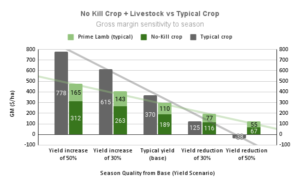
Figure 3. Modelled gross margin, Willydah No-Kill vs Typical Crop. Source: Vanguard Business Services.
Sensitivity analysis shows that Bruce’s low cost approach outperforms a typical approach in poorer seasons, which are projected to increase in frequency as a result of climate change. A key benefit (not factored into this analysis) is the increased options and therefore adaptability to variable conditions associated with Bruce’s approach. Depending on seasonal conditions and market fluctuations, Bruce can choose when and whether to sow, and whether and how much to graze his crop, or to harvest for silage, hay, or commodity markets. The No-Kill approach maximises the value of options in less favourable seasons.
Reduced cost, increased choice and flexibility, elimination of chemical use and reduced exposure to climatic and market volatility have all had a positive benefit on Bruce’s personal wellbeing. His approach substantially avoids the ‘boom and bust’ cycles that plague so many Australian farmers.
The complete elimination of fertiliser, herbicide, fungicide, and insecticide and avoidance of tillage has allowed plant and animal diversity to flourish at Willydah. Bruce estimates that their paddocks now contain more than 100 grassland species. Bruce has also planted more than 100,000 trees and retained remnant and regrowth paddock trees, although their health has declined in recent years, linked, Bruce believes, to passive chemical exposure. Nevertheless, a bird survey revealed that the farm provides habitat for more than 30 bird species, including two threatened woodland bird species.
Lab testing indicates that Willydah has generally good soil biological diversity and function, almost certainly a result of his focus on minimal disturbance and zero use of chemicals. The healthy state of his soils may explain his ability to continue to grow crops and pasture without reliance on synthetic inputs. The tests also showed improved soil function in sites with remnant and regrowth vegetation, which suggests the importance of trees for supporting healthy soil ecosystems, and adds to Bruce’s concern about chemical exposure from neighbouring properties.
Approach to collecting indicators
Farms are complex social and agro-ecological systems and each farmer has different goals, which means a different approach to monitoring is required for every farm. For Soils for Life case studies, we are guided by the case study farmer’s goals, and take a holistic view that includes an assessment of progress towards social/personal, ecological and financial outcomes. The information presented in this section is based on available data at the time of reporting, and may be influenced by seasonal or market conditions. This report should be read with this context in mind.
- Increasing plant and animal biodiversity
- Wellbeing of his animals, including through providing a diversity of plant species
- Lower priority on grain yield compared to many croppers
- Reducing the use of chemicals that impact biodiversity and soil and landscape health
- Reduced effort and input cost, including through eliminating chemical use
- Increased options and flexibility to adapt to weather and market conditions.
Monitoring of soil health at Willydah is a relatively new practice which Bruce and Liam are keen to embrace. Bruce and Liam want to understand how holistic management at Willydah is influencing soil health and, where possible, use soil observations and tests to refine and improve their current practices.
- Interviews and surveys with Bruce
- Reviewing information and data compiled over the years by Bruce
- Soil and landscape observations, and soil sampling at five sites across the farm
- Soil chemical and biological testing of the samples in the laboratory
- A bird survey.
Further details on these investigations are provided in the ‘Deeper insights’ sections below.
Deeper insights - Soil and landscape
Soil and landscape analysis method
Soil and landscape observations included:
- Above ground observations of vegetation and waterways
- Below ground observations of soil structure, colour, smell, plant roots, bacteria, and fungi.
In addition, soil samples were collected from 0-10 cm depth along a transect at five sites across the farm (see Figure 4 below). The samples were submitted for three complementary laboratory test suites, each of which provides a different perspective on the chemical and biological contents and condition of the soil. Each lab provides reference ranges against which the Young Seeds results can be compared:
- Agricultural Soil Analysis1Analysis undertaken by the Environmental Analysis Laboratory (EAL). Please refer to this EAL example of an Agricultural Soil Analysis Report for the EAL guidelines and ranges that SfL has used to guide interpretation in this report. – a suite of chemical tests to identify the available and total nutrient levels to support farm management.
- Haney Soil Health2Analysis undertaken by the Environmental Analysis Laboratory (EAL). Please refer to this EAL example of a Haney Soil Analysis Report for the guidelines and ranges that SfL has referred to in this report. – a suite of tests to indicate the size and functionality of the soil microbial community, including soil respiration, Water Extractable Organic Carbon (WEOC) as an energy source, and Water Extractable Organic Nitrogen (WEON) as a nutrition source.
- Soil Foodweb3 Analysis, guidelines and ranges provided by the Soil Foodweb Institute (SFI), which SfL has used to guide the interpretation in this report. – a snapshot in time of the types of microbial “workers” present in the soil.
The sites selected for soil sampling
Site 1 (Veg & NKC): Pasture paddock with remnant, regrowth and replanted trees and shrubs. No-Kill Cropping (NKC) of oats in 2021 and 2022 and grazed (not harvested) between each season with a percentage of the oats returning.
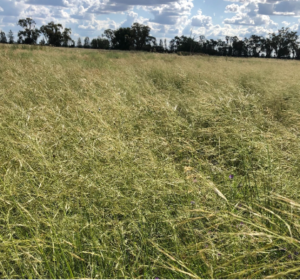
Site 2 (Veg, no cropping): A remnant and regrowth tree and shrub regrowth and replanting paddock without cropping that has been part of the grazing schedule.
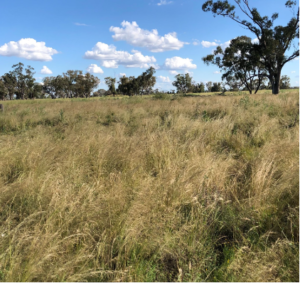
Site 3 (NKC): A grazing paddock that has also grown oats for several seasons using NKC. It was sampled when the oat crop was in head and a diverse canopy of other species were also present (“mother nature’s mix”).
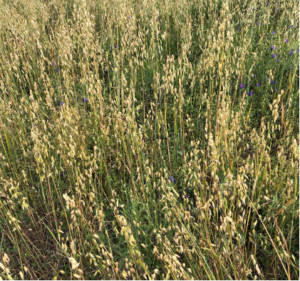
Site 4 (Front paddock NKC): Front paddock section with NKC: A long term pasture area in the paddock in front of the main house planted with NKC oats.
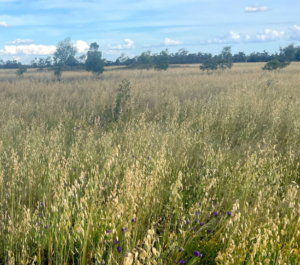
Site 5 (Front paddock no cropping): Front paddock section without NKC: A long term pasture area in the paddock in front of the main house where they have not recently grown any crops.
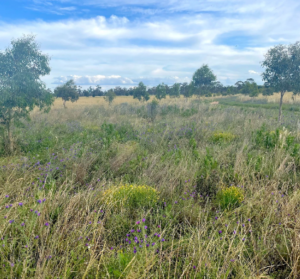
Interpretation of soil test results
Soil is one of the most complex ecosystems on the planet. The three laboratory test suites have been chosen to provide complementary perspectives on soil health, and contain a huge amount of information about soil chemistry, biology and functionality. However, they still represent a fraction of the complexity of the soil system, at a single point in time – in this case, the samples were collected in November, when the temperatures were rising, crops were nearing harvest, and there had been plenty of rain.
Importantly, the comparative averages, guidelines and ranges referred to in this report reflect those provided in the laboratory-generated reports and are not necessarily specific to the farming property, region, soil characteristics, history and management goals.
Snapshots of the results from these tests are shown in Figure 5 below, and the full results are provided in Appendices A, B and C. Note: Each row of results has been coloured using a grey scale, where the lightest colour is the lowest number and the darkest colour is the highest number in the row. Colour coding does NOT indicate positive or negative results, and is merely provided to allow simple visual comparison of the numbers in each row. The results need to be interpreted with care (repeated testing over time is necessary to produce reliable insights and trends).
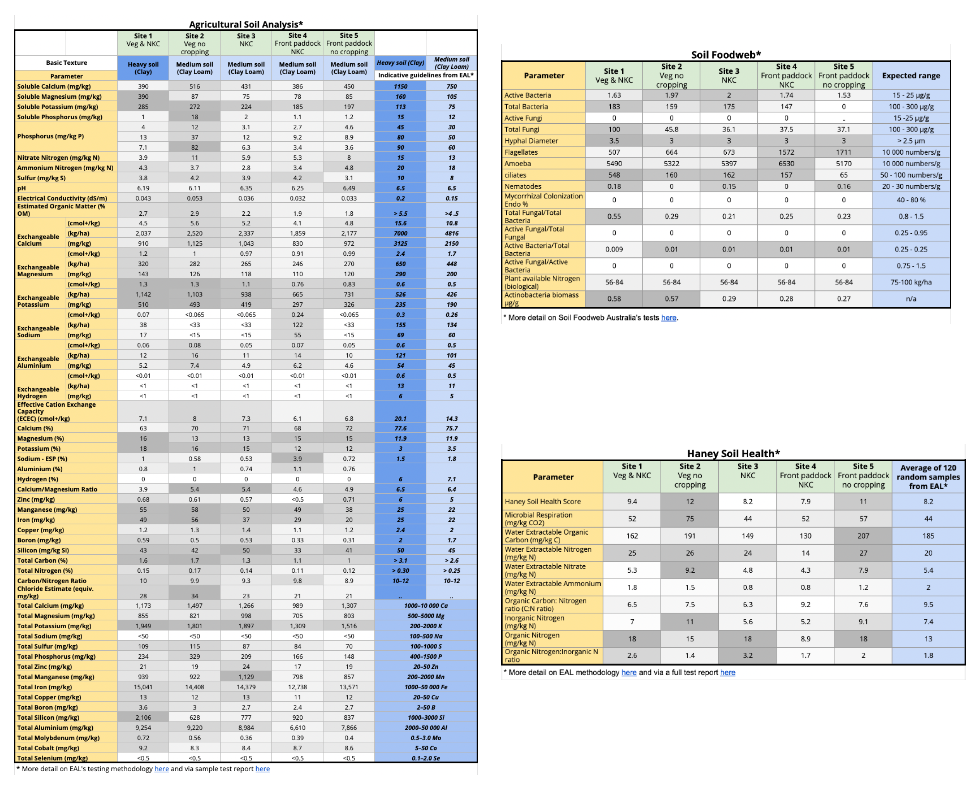
Figure 5. Snapshots of results from Willydah soil tests. Source: EAL; Soil Foodweb Institute; Soils for Life. See Appendices A, B and C for full detail.
- Overall, the soil biological communities at Willydah are reasonably diverse, with reasonably sized bacterial communities including the important actinobacteria being found at all sites, and beneficial fungal species.
- The ratio of water soluble organic to water soluble inorganic nitrogen across most sites is good, meaning these nutrients are available to feed soil biology and then support healthy plants.
- The biological nitrogen contribution from soil organisms across all sites at Willydah has been estimated at around 84 kg/ha.
- As would be expected, results from sites with remnant and regrowth vegetation are generally better than those without.
- There are low levels of some nutrients revealed in the Agricultural Soil Analysis chemical test results, compared to what might be expected in a traditional cropping system with fertility inputs. The other test results also suggest the diverse plants and biology in his system appear to be working efficiently to make nutrients from the total pool in the soil available to plants.
- A number of test results point to potential oxygen limitations in the soil (possibly caused by compaction), including the high numbers of ciliates, bacterial dominance in the soil food web, and low calcium to magnesium ratios – although it’s important to note that the samples were taken in a wet year, which may have contributed to these results (waterlogging can cause low oxygen levels).
- Water extractable carbon to nitrogen ratios are below average according to the lab’s benchmarks, which could be a result of an active biological community at the time of sampling, exhausting available carbon reserves.
- The results indicate some nutrient base saturation percentages are outside the ideal ranges recommended by EAL, including magnesium (higher than ideal, which can affect plants’ calcium, phosphorus and potassium uptake) and potassium (higher than ideal, which can affect calcium and magnesium function) – both of these can also compromise the otherwise good calcium base saturation percentage.
- Organic matter (%) and effective cation exchange capacity (ECEC)4Effective cation exchange capacity (ECEC) is a measure of the soil’s capacity to absorb and hold positively charged base cations (Ca2+, Mg2+, Na+, K+) and exchange acidity (H+, Al3+, Mn2+). As soils become more acidic, the ECEC is a better estimate (than CEC) of their capacity to retain positively charged ions. were both below the lab’s benchmarks across the five sites, although both were higher in the areas of remnant vegetation. Higher levels of soil organic matter are associated with improved cation exchange capacity.
- Fungal communities at Willydah are small in size according to these test results, but include beneficial species that support plant growth (indicated by higher than average hyphal diameter).
Bird survey
To explore bird abundance and diversity, the Maynards have had two bird surveys undertaken on Willydah: the first in March 2003 by NSW Department of Infrastructure, Planning and Natural Resources and the second in November 2022 by Soils for Life. Follow the link below for more details.
While a single survey event does not allow for observing seasonal fluctuations and migratory species, several indicators of bird diversity on Willydah can be reported.
In 2022, a total of 274 individual birds and 27 species were observed. Incidental sightings raised the count to 800 individuals and 42 species. The Noisy Miner was the most abundant (58 individuals), followed by the Eastern Rosella (26), Australian Wood Duck (25), Australian Magpie (21), and White-winged Chough (19).
The Autumn 2003 and Spring 2022 surveys showed different species compositions. The 2003 survey recorded 32 unique species (not seen in 2022) and the 2022 surveys recorded 12 unique species. Five species of honeyeaters were recorded in 2003, compared with one (the Noisy Miner) in 2022. Three nocturnal species were recorded in 2002; whereas, none were recorded in 2022. However, both surveys recorded the Superb Parrot and Grey-crowned Babbler, two threatened woodland bird species.
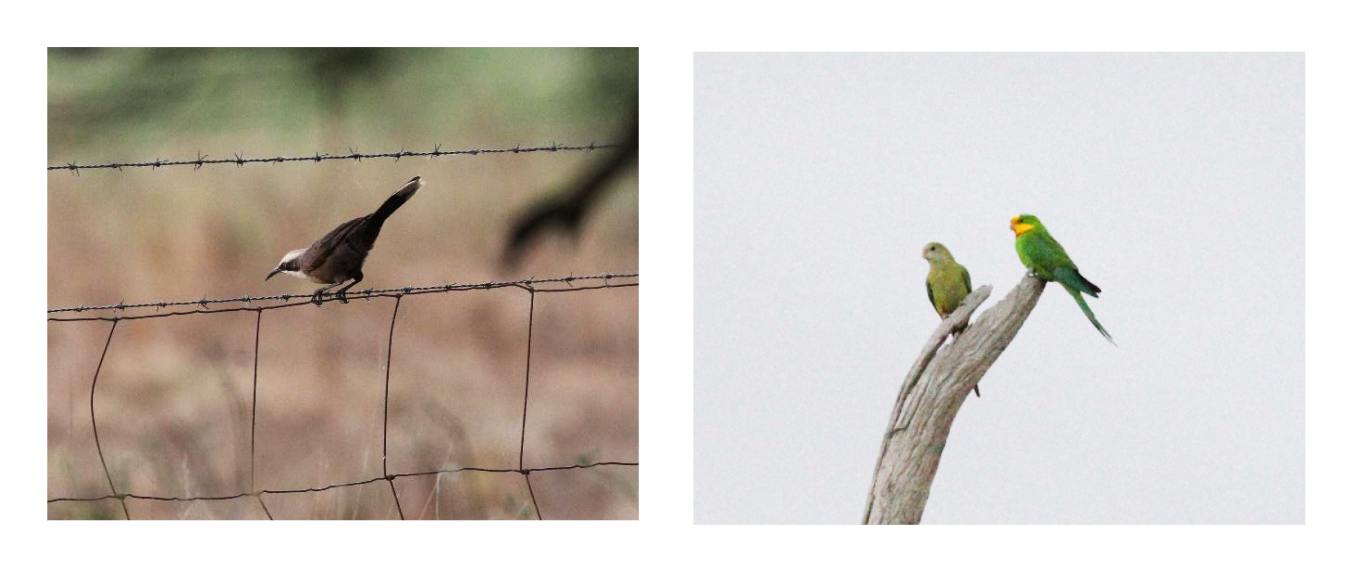
Image 2 & 3: Threatened woodland bird species (left) Grey-crowned Babbler and (right) Superb Parrot observed in March 2003 and November 2022.
In order to understand the long-term diversity, abundance and bird assemblages at Willydah over time, it would be important to systematically survey Willydah, for example with replicated annual surveys. There is an undisputed value in long-term monitoring programs, providing invaluable insights regarding woodland bird decreases in agricultural areas (Hughes, et al. 2017; Lindenmayer, 2021). The Maynard family also holds a family egg collection from Willydah collected in the 1940s, which could provide an additional data source of species once present on Willydah.
Bruce expressed concern about Passive Chemical Exposure influencing bird populations over the past decade. Passive air sampling would be required to confirm levels of PCE, but current literature demonstrates the effect PCE has on all living organisms5 While little published research exists for Australia, Austrian research has found significant levels of chemicals in the air, posing a threat to biodiversity and humans (Zaller et al., 2022), including invertebrate and amphibian species (Bruhl et al, 2013). . Additionally, conducting replicated annual surveys (at least) would further the understanding of bird trajectories on Willydah within agricultural, remnant and re-vegetated areas. This would also provide important monitoring of vulnerable species such as the Superb Parrot and Grey-crowned Babbler and the woodland dominating species, the Noisy Miner.
Deeper Insights - Farmer and farm
Personal and family
To explore farmers’ perception of change in their personal relationships over time, Soils for Life created a wellbeing survey of six themes with associated indicators (Table 1). Farmers ranked each of these indicators, across all four phases, on a seven point scale from: very unhappy (1); unhappy (2); mostly dissatisfied (3); mixed (4); mostly satisfied (5); pleased (6); to very pleased (7). We then averaged the indicators to graph the ‘theme averages’ and observe their relative change over time, across the four phases (Figure 9). We also indicate below where any specific indicators are outliers in comparison to the general trend of other indicators in its theme.
Table 1. The six themes and indicators of personal relationships in the wellbeing survey.
| Relationships with | Indicators |
| Self |
|
| Family |
|
| Friends and community |
|
| Farming |
|
| Land |
|
| Life |
|
Generally, Bruce perceived positive changes in his personal relationships across his development and refinement of No-Kill Cropping (Figure 6). The most marked increases were in his connections to self, farming, land and life more generally. He began his farming journey feeling unhappy and mostly unsatisfied in these relationships, whereas now he is pleased and very pleased with these relationships. The quality of his relationships with his family started as mixed, but this also continued to improve, and he is now very pleased.
Bruce’s perceived connections to friends and community has steadily remained as mixed, perhaps in part because of the local community’s mixed reception to Bruce’s approach and his work around Passive Chemical Exposure.
Figure 6. Bruce’s perceived quality of connections over time across six themes (where 1 denotes very unhappy and 7 denotes very happy). Source: Soils for Life.
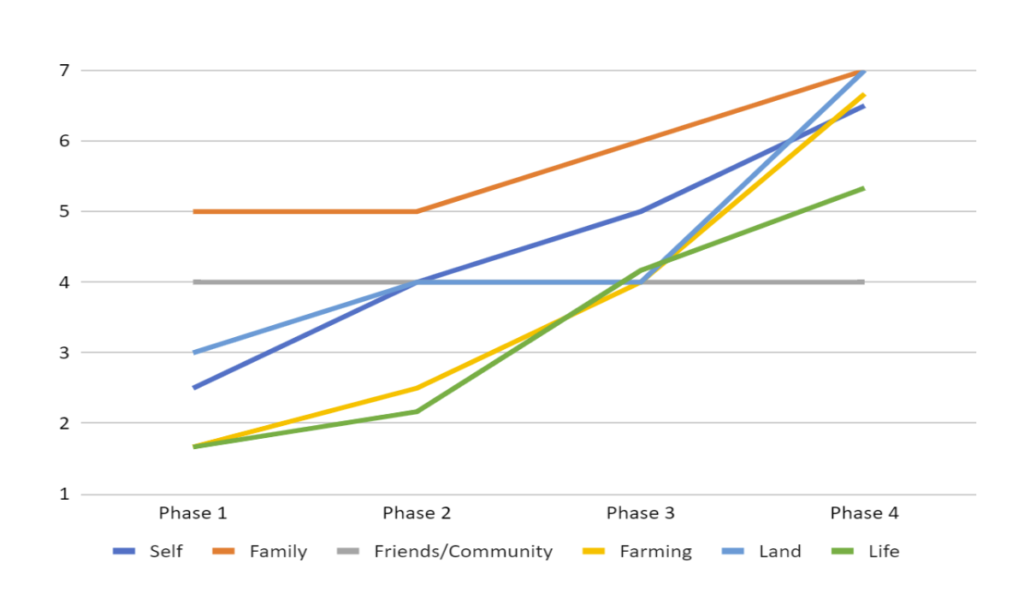
As mentioned above, the lines in Figure 9 represent an average of all the indicators within a theme (in Table 2). However, it is important to note where an indicator may have deviated from the average of a theme (that is, is greater than 2 points of difference from the average). Within each theme, Bruce assessed each of the indicators similarly. The most noteworthy difference between indicators in a theme for Bruce is in Stage 4 regarding his relationship to the theme of life. While he is pleased with his standard of living, what he can achieve in life, his level of contentment, and life as a whole, he feels mixed about his safety and future security, largely because of the growing challenges of climate change and passive chemical exposure on his property.
Business outcomes
The No-Kill Cropping method significantly reduces interventions in the landscape normally associated with crop production. A key objective is to maximise diversity and support ongoing improvement in soil health and landscape function, ultimately improving the farm’s bottom line. According to Bruce, No-Kill Cropping recognises that ‘maximum production does not equal optimum profitability’. Rather, Bruce seeks profitability, to a large extent by focusing on reducing costs to improve Gross Margins. As part of this case study, Vanguard Business Services estimated Willydah’s 2022 Gross Margin (GM), which includes two enterprises:
- The No-Kill Crop direct-drilled into a healthy diverse grassland, and
- The livestock grazed for a substantial period of the year on perennial pastures during the non-growing season of the crop, as a low cost tool to manage the landscape for the cropping cycle.
When modelled against different seasonal conditions it is evident that No-Kill cropping generally produces a lower GM than conventional cropping, however it supports stacking on a grazing enterprise very well. When the additional GM from a grazing enterprise is added, the GM can be almost the same as a typical operation in a typical year, and much better in poor years (Figure 7). Reduced risk is an important aspect of this. Variable costs are significantly lower, however there are other cost benefits from reduced machinery requirements and associated capital costs; as well as lower labour requirements and much greater flexibility around timing of operations. These benefits are difficult to quantify and have not been included in the GM analysis.
Figure 7. Willydah Gross Margin Sensitivity to Season – No-Kill vs Typical Wheat Crop (Vanguard Business Services). Source: Vanguard Business Services.
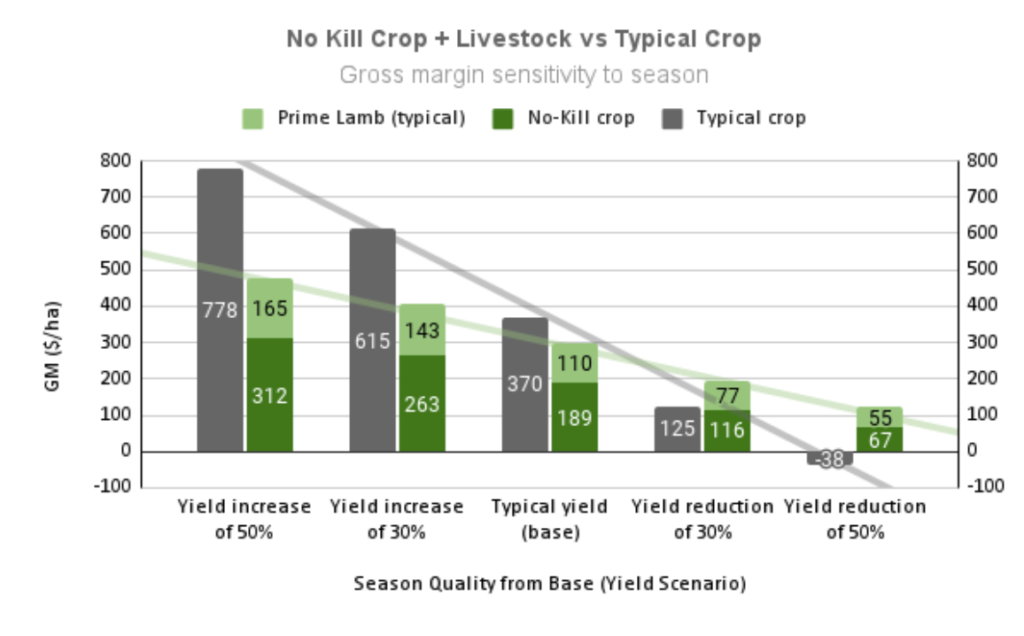
Importantly, the No-Kill Cropping approach also provides a lot of flexibility to respond to external factors such as seasonal conditions, commodity prices and the needs of livestock enterprises. While the Maynards do not produce as much grain as neighbours, they have very low costs and lots of options; this means that, depending on the markets, they can graze or harvest for silage, hay, or commodity markets. Bruce believes this flexibility equals resilience for their business and themselves.
Production output and quality
With analysis of his records over time, Bruce has calculated that his approach, including No-Kill Cropping, has tripled the property’s stocking rate compared to the historical carrying capacity, in terms of Dry Sheep Equivalent (DSE). Prior studies on Willydah have also indicated that No-Kill Cropping has increased his biomass by up to 30 – 40%, compared with a regular cropping paddock or a regular grazing paddock.
Like many regenerative farmers, Bruce is interested in the potential for new markets where he can sell better-quality, nutrient-dense grain. Nutrient density of food is an important potential outcome of farming in healthy, functional soil. However, the role of regenerative farming practices and the impact that the soil health and farming methods has on the overall nutrition content has not been widely documented or widely engaged within the Australian landscape. Recognising this, Bruce Maynard has participated in a pilot nutritional study into the nutrient content of wheat and oat samples at Willydah – stay tuned for further information on this pilot study.
Appendices - Soil test results
Appendix C. Willydah Soil Foodweb Institute Results

* More detail on Soil Foodweb Institute Australia’s tests here.
Appendix A, B & C: Each row of results has been coloured using a grey scale, where the lightest colour is the lowest number and the darkest colour is the highest number in the row. Colour coding does NOT indicate positive or negative results, and is merely provided to allow simple visual comparison of the numbers in each row.
References
ABC Television (2022) Landline [television program], ABC Television, Sydney.
Australian Centre on Quality of Life (2020) Personal Wellbeing Index. Retrieved from <https://www.acqol.com.au/instruments#measures>.
Brown K, Schirmer J and Upton P (2021) ‘Regenerative farming and human wellbeing: Are subjective wellbeing measures useful indicators for sustainable farming systems?’ Environmental and Sustainability Indicators, 11(100132): https://doi.org/10.1016/j.indic.2021.100132
Brühl CA, Schmidt T, Pieper S and Alscher A (2013) ‘Terrestrial pesticide exposure of amphibians: an underestimated cause of global decline?’ Sci. Rep. 3(1135).
Harris PS, Biggs AJW and Stone BJ (eds) (1999) Central Darling Downs Land Management Manual. Department of Natural Resources, Queensland. DNR 990102.
Hughes BB, Beas-Luna R, Barner AK, Brewitt K, Brumbaugh DR, Cerny-Chipman EB, Close, SL et al. (2017) ‘Long-term studies contribute disproportionately to ecology and policy’ BioScience, 67: 271–281.
Isbell RF and the National Committee on Soil and Terrain (NCST) (2021) The Australian Soil Classification (Third edit). CSIRO Publishing, Melbourne.
Lindenmayer D (2022) ‘Birds on farms: a review of factors influencing bird occurrence in the temperate woodlands of south-eastern Australia’, Emu – Austral Ornithology, 122(3-4): 238-254.
Masters N (2019) For the Love of Soil: Strategies to Regenerate our Food Production System, Integrity Soils, USA.
Regional Wellbeing Survey (RWS) (2020) The University of Canberra. Retrieved from <https://www.regionalwellbeing.org.au/project/regional-wellbeing-survey-user-guide/>.
Schirmer J, Yabsley B, Mylek M, and Peel D (2016) ‘Wellbeing, resilience and liveability in regional Australia: The 2015 Regional Wellbeing Survey’, University of Canberra, Canberra.
Zaller J et al. (2022) ‘Pesticides in ambient air, influenced by surrounding land use and weather, pose a potential threat to biodiversity and humans’, Science of the Total Environment 838(2): https://doi.org/10.1016/j.scitotenv.2022.156012
Full Reports
External Links
Your Questions
Do you have questions or feedback? We’d love to know more about you and your needs around our case study reports, get in touch.
To hear the latest, follow us on social media or subscribe to our newsletter.
This project is supported by the Australian Government’s Smart Farms Program.




